#Late Tang Dynasty Period
Explore tagged Tumblr posts
Photo
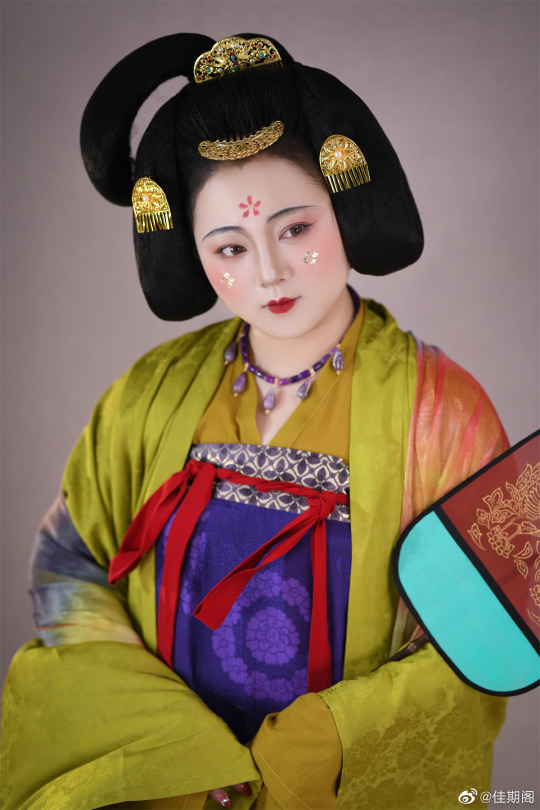
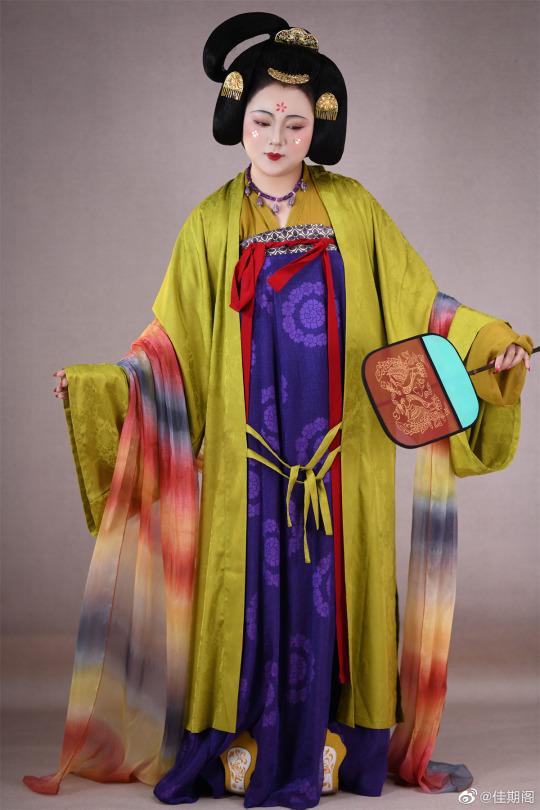
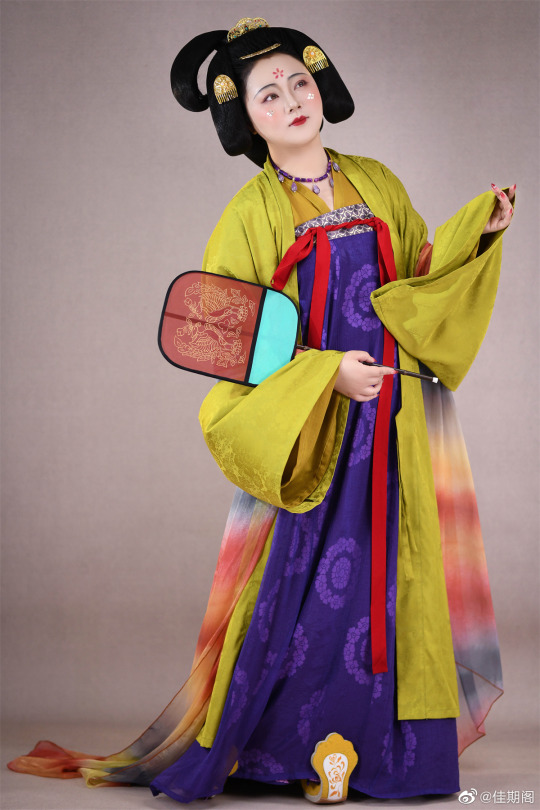

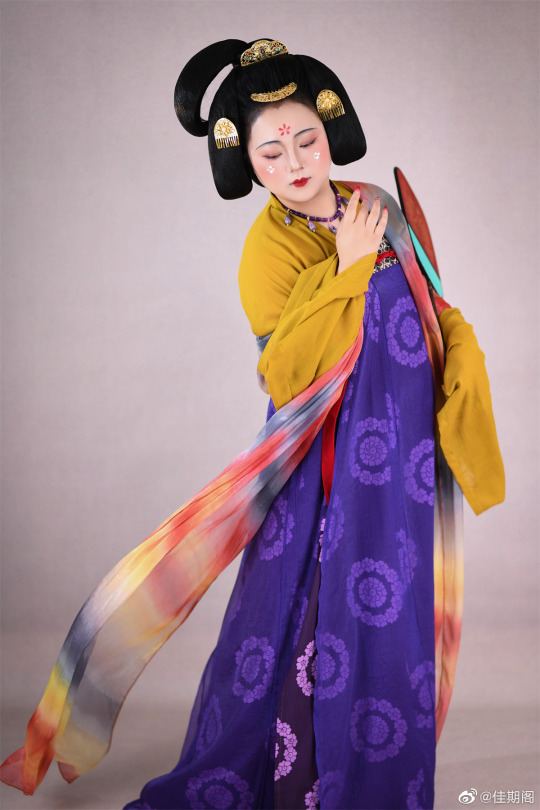
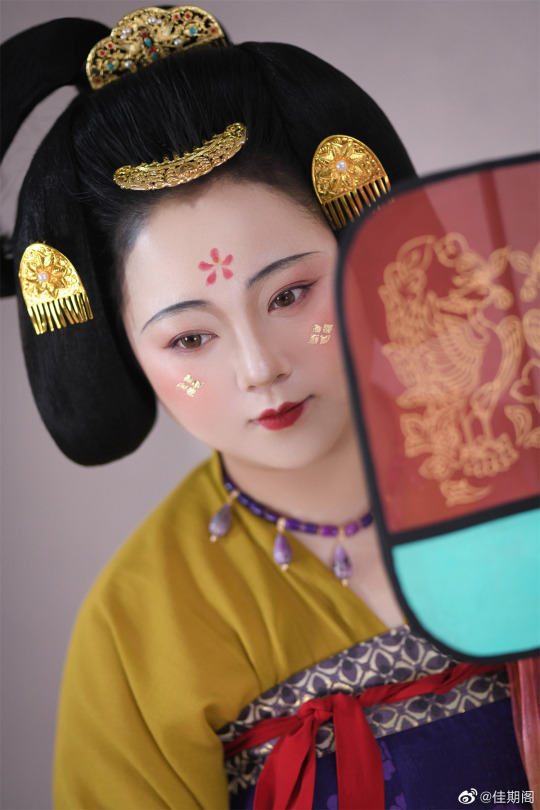
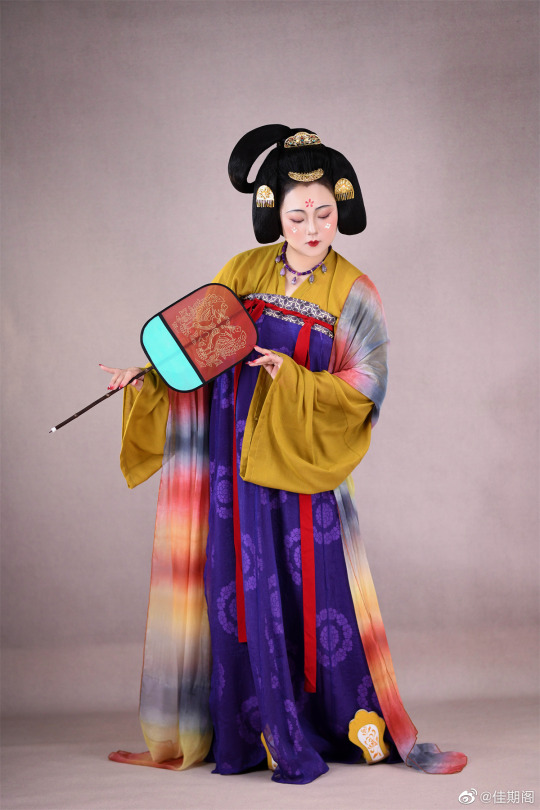
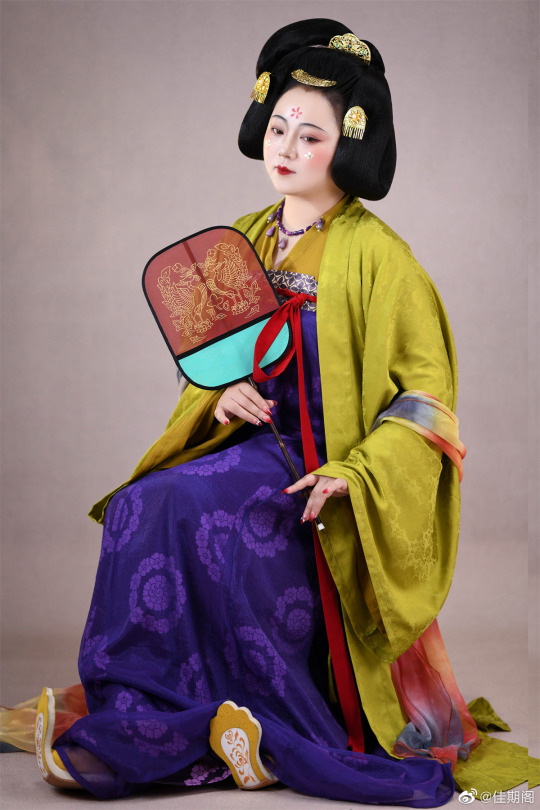
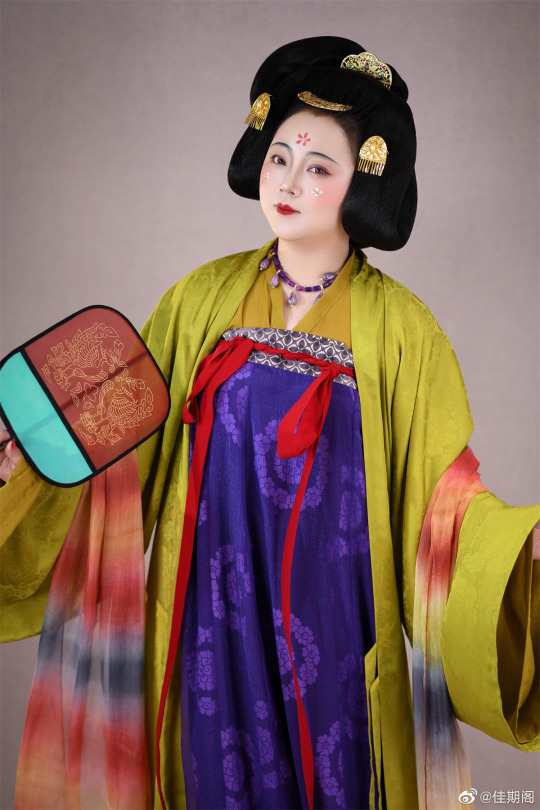
【Historical Reference Artifacts】:
Tang Dynasty Hanfu Relics Unearthed from the Underground Palace of Famen Temple
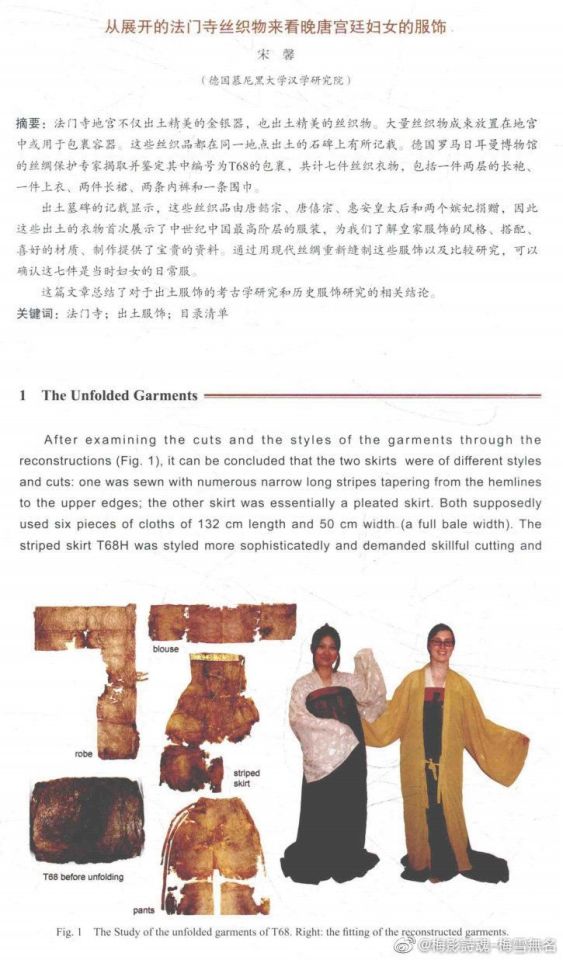
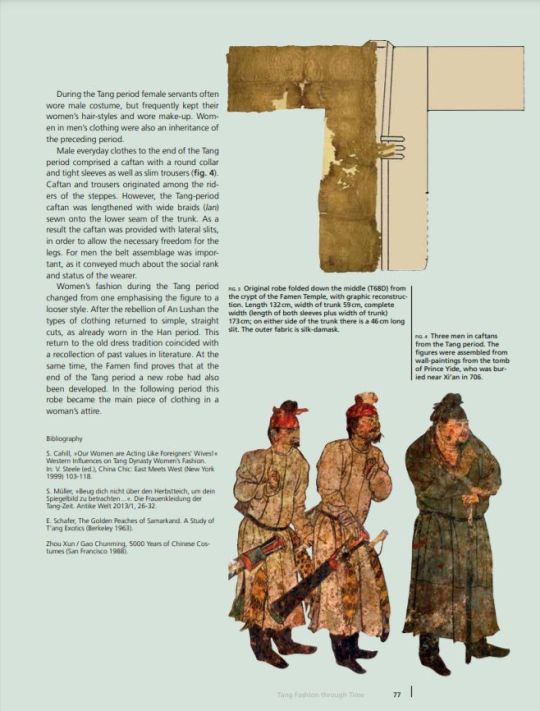
Tang Dynasty Hanfu Relics Unearthed from the Underground Palace of Famen Temple:直領對襟團窼紋長衫(袍)
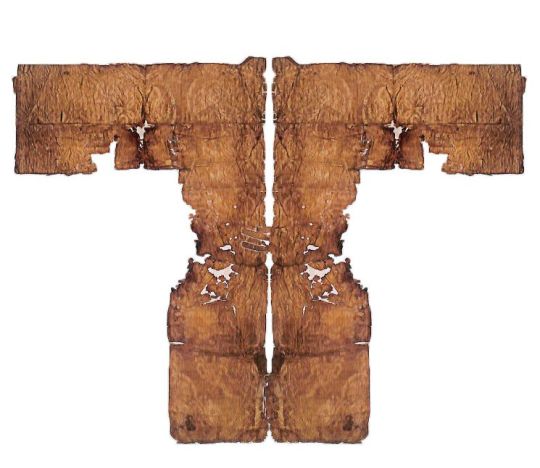
[Hanfu · 漢服]Chinese Tang Dynasty(618-907A.D)Traditional Clothing Hanfu Refer to the relics of Famen Temple
Late Tang Dynasty Period Noblewoman Attire
_______
👗Hanfu & Photo: @佳期閣
🔗Weibo:https://weibo.com/6614078088/N2FqMr2U6
🛍️ Tabao:https://item.taobao.com/item.htm?spm=a1z10.3-c.w4002-21517525888.12.3ed71c81WrejrM&id=722671302802
_______
#chinese hanfu#Tang Dynasty(618-907A.D)#hanfu history#hanfu accessories#hanfu#hanfu artifacts#chinese historical fashion#chinese historical makeup#chinese history#chinese style#chinese#chinese attire#chinese traditional clothing#chinese culture#直領對襟團窼紋長衫(袍)#Famen Temple#汉服#漢服#佳期閣#Late Tang Dynasty Period#chinese fashion#china
152 notes
·
View notes
Text
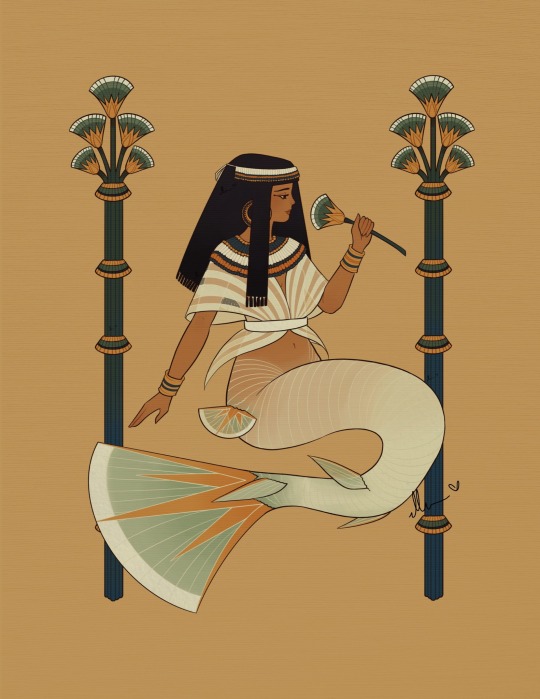


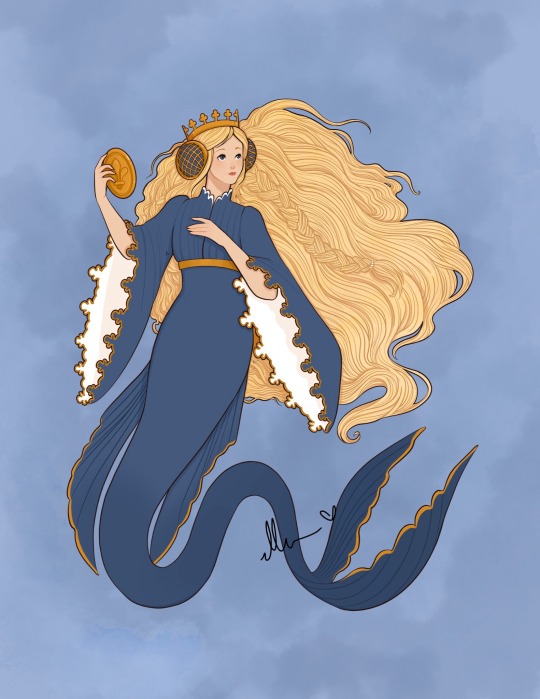
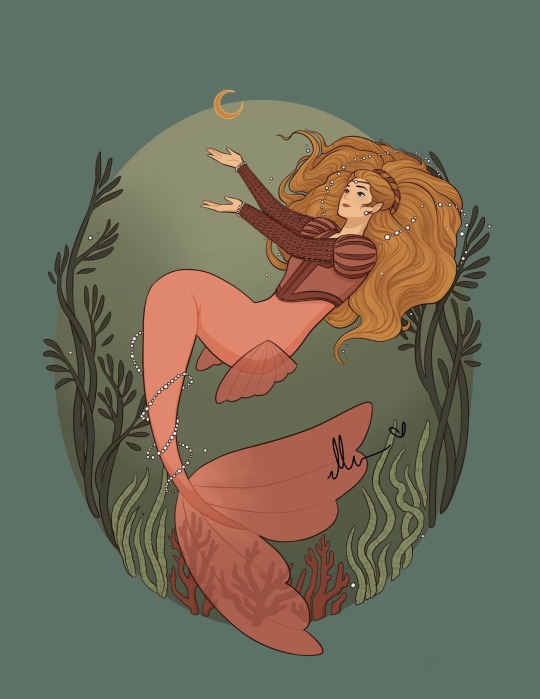
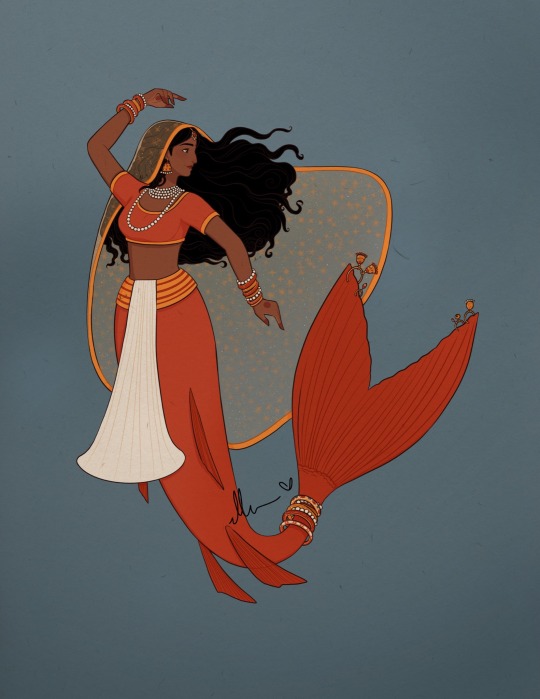


All the Historical Mermay’s together!
I had a lot of fun with this mermay prompt list by chloe.z.arts and they turned into a pretty cool collection of illustrations!
Prompt list by chloe.z.arts on instagram.
I am the artist! Do not post without permission & credit! Thank you! Come visit me over on: instagram.com/ellenartistic or tiktok: @ellenartistic
#historical mermay#mermay 2023#collection of mermaids#lnart#ellenart#historically inspired#historical fashion#it’s gonna be mermay#ancient egypt#ancient greece#tang dynasty#french medieval#italian renaissance#mughal empire#edo period#late victorian era
4K notes
·
View notes
Text
April 20, Beijing, China, National Museum of China/中国国家博物馆 (Part 3 – Chinese Historical Fashion Exhibition):
Another cool exhibition that I visited while at the museum, showcasing popular fashion from different dynasties, historical artifacts, and some other relevant artifacts that gave a glimpse into the fashion of different dynasties. What's even cooler is that you can visit this exhibition virtually! (the site is in Chinese but I highly recommend it to everyone, there's so much more to the exhibition than the pictures I post here) Note that this exhibition does not only include historical hanfu, but also historical fashion of the 少数民族 that ruled some of the dynasties. This post will be pre-Ming fashion, and next post will be Ming and Qing era fashion. The reason is because Ming and Qing dynasties are the two most recent dynasties, so there are a lot of surviving artifacts from these two dynasties, which means there are 30+ pictures total and I couldn't fit them all into a single post.
First is a recreation of Han-era (202 BC - 220 AD) hanfu. The woman on the left is wearing a one-piece robe called a qujushenyi/曲裾深衣. The man on the right is wearing the outfit characteristic of Eastern Han dynasty (25 - 220 AD) civil officials, a combo of jinxianguan/进贤冠 hat and zaochaofu/皂朝服 clothing (皂 here means the color black, as in the word "青红皂白", or "blue and red, black and white"):
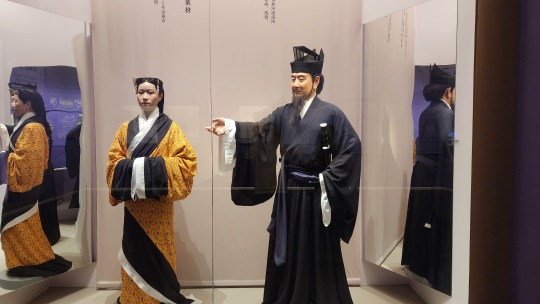
Left: model of a Han-era magpie tail cap/queweiguan/鹊尾冠 (you can see the influence of these Han-era men’s hats on the outfits of male characters in modern xianxia art). Right: recreation of a Han-era bian/弁 hat (the headscarf-like piece tied beneath the chin):
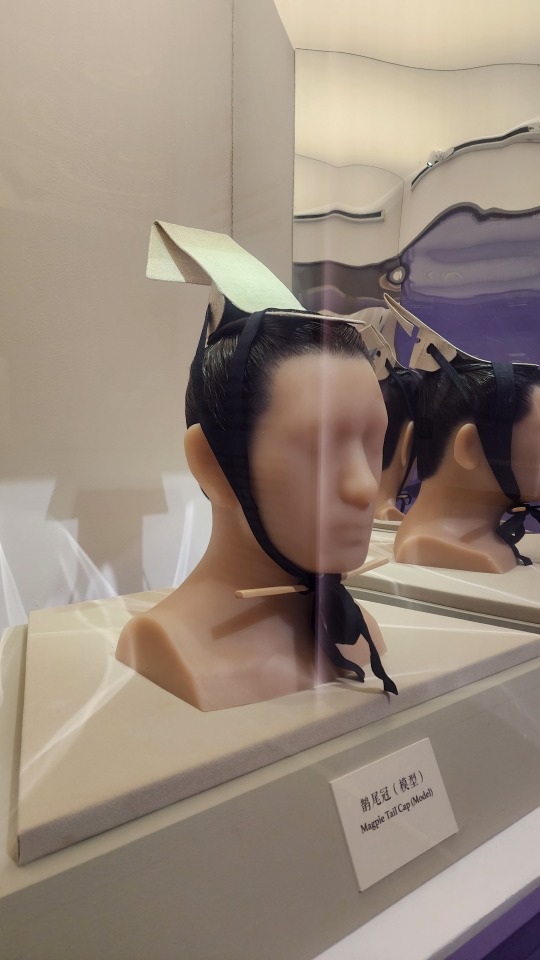
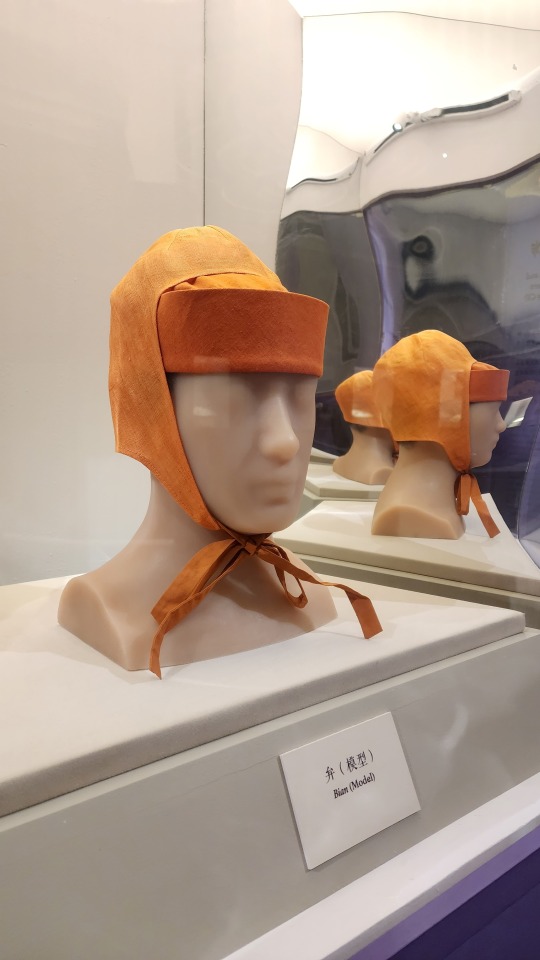
Line drawings of different hats worn by different types of officials based on artifacts and murals. The center and left sections are different hats of military officials (wuguan/武官 in Chinese), and the right section is different hat styles of civil officials (wenguan/文官 in Chinese).
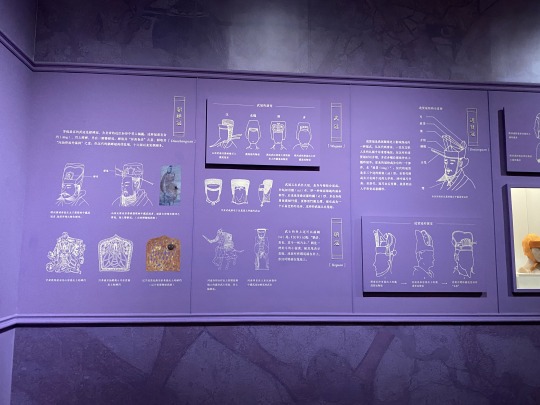
Jumping back, this is a Warring States period (476 - 221 BC) iron daigou/带钩 inlaid with gold and jade and decorated with dragons. Daigou are basically belt buckles where the flat end is attached to one end of the belt, and the hook will hook into slits in the other end of the belt, so this is an extra fancy belt buckle:
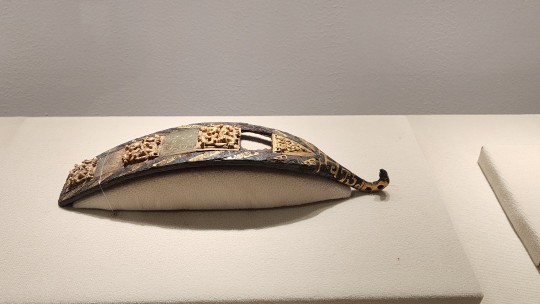
On to Tang-era (618 - 907 AD) hanfu. From the left to right these are: the regular outfit of early Tang dynasty officials (color varies by rank, red is worn by fourth and fifth rank officials), the outfit of a female servant in early to mid Tang era, the ceremonial outfit of a Tang dynasty emperor, and the outfit of noblewomen in late Tang to Five Dynasties era (907 - 960 AD):
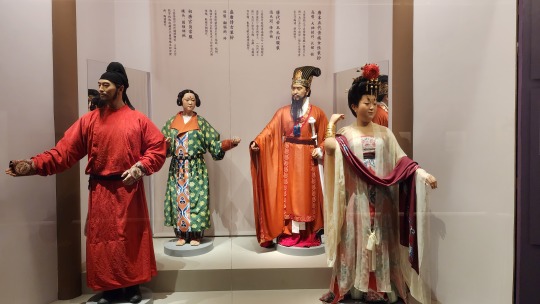
Song-era hanfu (front two) and Yuan-era Mongolian fashion (back two). Front left is the formal attire of Southern Song dynasty (1127 - 1279) civil officials (color varies by rank, red is worn by fourth and fifth rank officials), and front right is the regular outfit of women in Southern Song dynasty. Back left is the formal attire of Mongolian noblewomen in Yuan dynasty (1271 - 1368), and back right is the regular outfit of Mongolian men in Yuan dynasty.
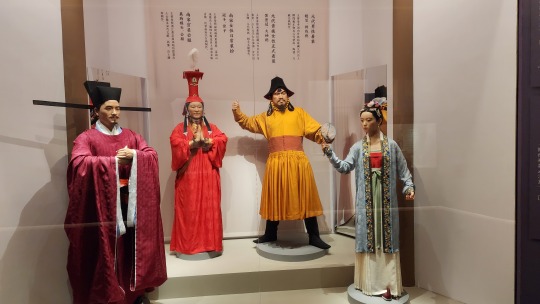
Replicas of painted clay sculptures of women from Northern Song dynasty (960 - 1127), the original sculptures are in Hall of the Holy Mother/圣母殿 of Jinci Temple/晋祠 in Shanxi province:
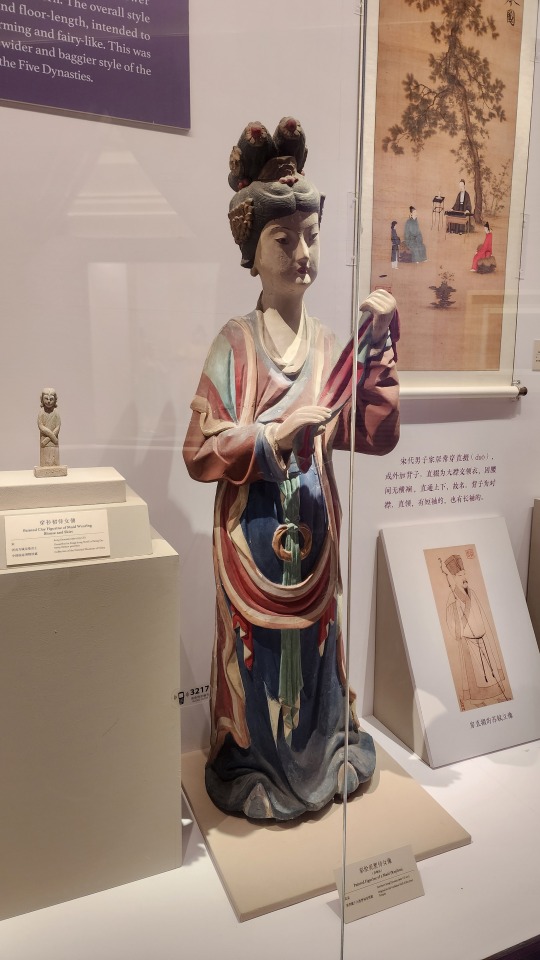
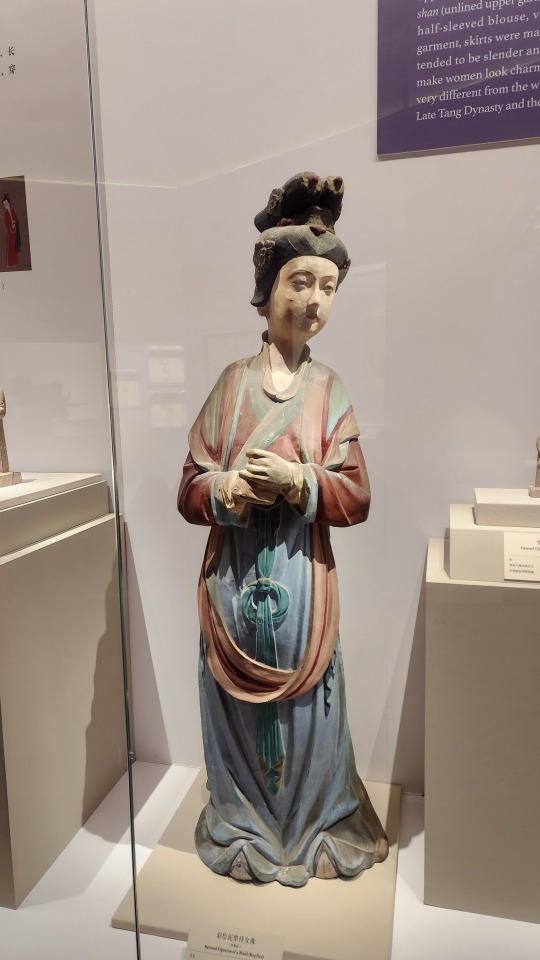
By the way, in the case of Song dynasty, the descriptor "northern" and "southern" basically indicate time periods within Song dynasty (you can refer to the beginning of this post where I explain this in more detail).
And line drawing diagrams of different styles of futou/幞头 hats in Song dynasty based on paintings, murals, and other artifacts:
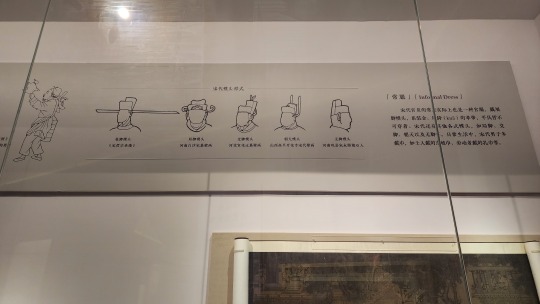
#2024 china#beijing#china#national museum of china#historical fashion#historical clothing#chinese historical fashion#hanfu#mongolian historical fashion#fashion history#chinese history#chinese culture#history#culture
140 notes
·
View notes
Text
"In historical context though-"
This book has potatoes and chilis in supply and demand when these were not traded until the late 15th century... and not used for cuisine and a foods crop cultivator in China well into the 17th and 18th century almost 200 years later. Folding fans that are seen abundantly were not popularized until the 13th century. Taoism was at its largest during the Warring States period of 450 BCE–c. 300 BCE with the epigram of Tao Te Ching. Confucianism became the abundant practice as of 206 BCE to 220 BCE with the authoring of The Analects. It uses fabricated province names for real world Chinese provinces that are relegated to a simple five, when there are of 22 (claimed) and have been the most stable to survive since the Yuan dynasty 1271-1368. Idioms used vary through the centuries and are still a staple of modern day vernacular. The version of futou Jin Guangyao alone wears was a wushamao (乌纱帽), used in the Ming dynasty 1368-1398. Futou was made a part of ministerial and court attire during the reign of Emperor Wu 560 BCE.
The author has said it has no standing Imperial Dynasty it takes place in and has borrowed aesthetics from the Han, Wei-Jin, Song, Tang, Ming and even Qing. All of which had seen several turns of dynasty from Han to Mongol to Han divine rulings. So no, there is no historical context to take in regard when it comes to Madam Yu's overt abuse, to Jiang Cheng's abuse, the clan's classisms and hypocrisy.
It was written in an alternate fantasy of China without this context of real world history and through the lens of modernity of its author. Do not use a history that does not pertain to a novel that is not has not and was never called historical.
129 notes
·
View notes
Text
#TextileTuesday:

Textile with Animals, Birds, and Flowers Eastern Central Asia, late 12th–14th century Silk embroidery on plain-weave silk 14 5/8 x 14 7/8 in. (37.1 x 37.8 cm) Metropolitan Museum of Art, New York 1988.296
"This textile demonstrates the longevity of motifs in eastern Central Asia. The placement of animals—a spotted horse, a rabbit, and two deer (or antelope)—at its cardinal points is a compositional device that began to appear in the region during the Han dynasty. The birds on the piece, especially the parrot, entered the Central Asian repertoire during a second period of strong Chinese influence, the Tang dynasty. The floral background's central motif of lotus blossoms, a lotus leaf, and a trefoil leaf was seen in Central Asia and North China but became widespread during the Yuan dynasty."
#animals in art#birds in art#textile#Textile Tuesday#embroidery#silk#Central Asian art#Asian art#Metropolitan Museum of Art New York#animal iconography#medieval art
66 notes
·
View notes
Text

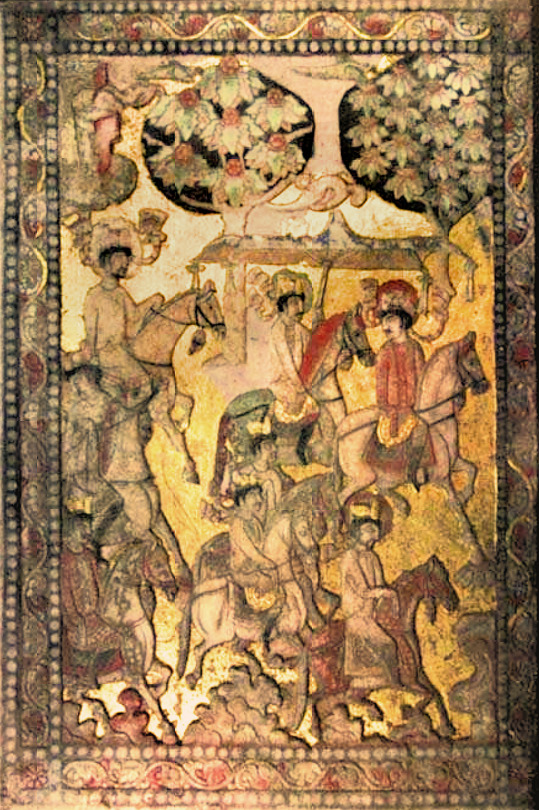
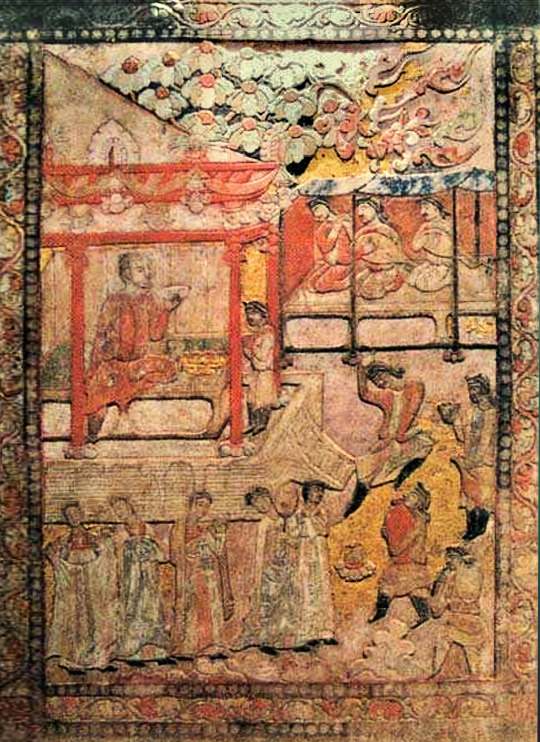
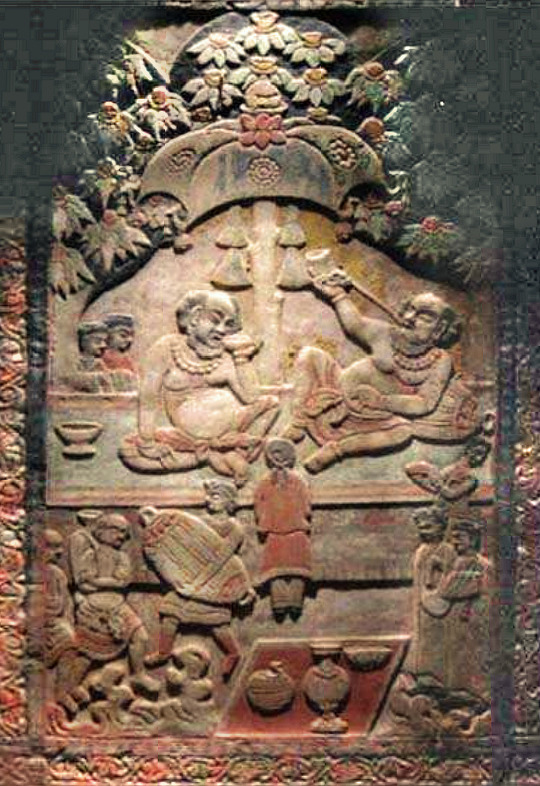
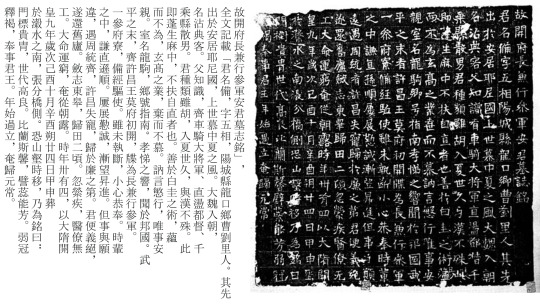
Tomb of An Bei 589 CE. Sogdian tomb.
I couldn't find the translation for the epitaph for this one.
"Differently from the other tombs quoted in this paper, Anbei’s tomb was not excavated by archaeologists, but found and looted by the robbers, therefore the archaeological context of this tomb, even the date of this accidental finding are lost. Until now, all we know is that this tomb robbery happened someday between 2006 and 2007. Several stone figurines, a funerary couch and Anbei’s epitaph stone were found in the tomb. Two stone figurines, parts of the base of the couch and the epitaph are now exhibited in the Tang West Market Museum in Xi’an (Fig.20), four panels belonging to the private owners, including two processing and two banqueting scenes, were published, too (Fig.21).
Although owning the typical Sogdian name An, which means his ancestors migrated into China from Bukhara, his homeland was described in a completely different name, the state of Anjuyeni, which was never recorded by any source before. An’s family moved to China during the Northern Wei dynasty, some of his family members once served in the Bureau of Tributaries. For the court, it’s also an usual way to adopt expatriate immigrants to work in the diplomatic system. Anbei’s father, An Zhishi, served as a middle-rank commanding officer among the honour guards of the court.
As a, likely, third generation immigrant, Anbei’s life depicted in the epitaph was very brief, too. Except for the usual eulogies commonly written in every epitaph, two main parts of his experience were emphasized: his mercantile ability and simple bureaucratic career. The one who wrote the text made a metaphor, assimilating Anbei with two famous ancient Chinese merchants, Baigui and Xiangao during the Eastern Zhou Period (approximately between 8th c. - 3rd c. BC); After that, Anbei’s only short official career as a very lower status clerk of the military headquarters of vassal leader Xuchang was recorded, probably happened in 575 AD when he was 20 years old. Soonafter the Northern Qi was replaced by Northern Zhou dynasty in 577 AD, Anbei returned home in Luoyang, the place where he died and was buried in 589 AD at the age of 34.
The motivation for me to list this robbed tomb here, together with the other tombs which have detailed background obtained through scientific archaeological excavation is, however, mainly not for its elaborate funerary couch, but because of his distinctive identity depicted in the epitaph. Prior to the discovery of Anbei’s tomb, the deceased of all five tombs which constituted the most important foundation of the studies of the foreign immigrants in early medieval China, namely the tombs of Lidan, Kangye, Anjia, Shijun and Yuhong, owned high-ranked official positions such as head of a prefecture or Sabao, which may result in a misconception that only aristocrats of the foreign immigrants could be buried with such elaborate funerary furniture. However, Anbei’s tomb provided an additional possibility about the status of the tomb occupant who used the stone funerary furniture. What is expressly shown in the epitaph, during his 34-year-long life, Anbei was just a very ordinary person, without any notable ancestry from homeland, neither held any high-ranked post, nor received anyone as a posthumous reward.
Except for the basic information above, there is also a remarkable narration during the introduction in the beginning of Anbei’s epitaph, which may reflect the collective mindset among most of the foreign immigrants in China and their efforts in social integration, ‘Although he is a foreigner, after a long life in China, there is no difference between him and the Chinese’.
-Yusheng Li, Study of tombs of Hu people in late 6th century northern China
210 notes
·
View notes
Text


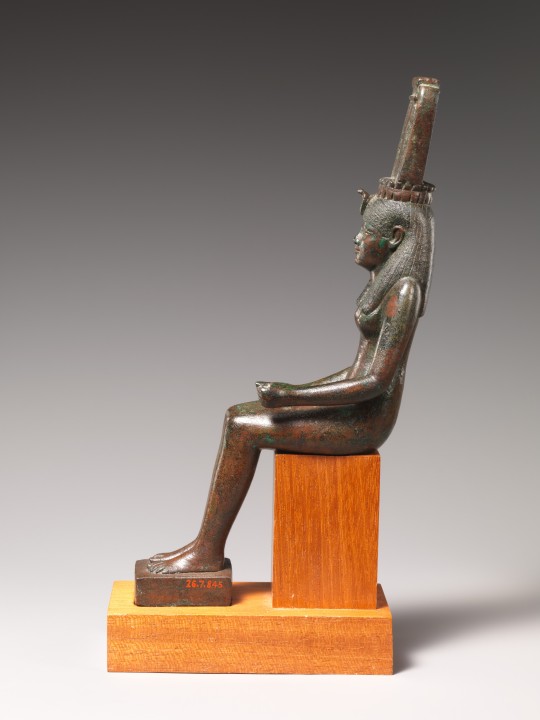
Statue of a goddess, probably Nehemetaui or Nebethetepet Late Period–Ptolemaic Period Dynasty 27–30 550–300 B.C.
The shrine-shaped sistrum sound-box worn as a crown by this figure indicates that either the goddess Nehemet-aui, the consort of Thoth, or Nebethetepet, a manifestation of Hathor, is represented. The features of the goddess suggest a date to the end of the 26th dynasty, or the 30th dynasty. As the kings of the 30th Dynasty built important buildings including a temple to the goddess Nehemet-aui at Hermopolis, the seat of the god Thoth, it is plausible this statue is Nehemet-aui.
H. 17.8 × W. 4.3 × D. 10 cm (7 × 1 11/16 × 3 15/16 in.). H. (with tang): 20 cm (7 7/8 in.).
#Statue of a goddess#Nehemetaui#Nebethetepet#Late Period–Ptolemaic Period#statue#egyptian statue#ancient artifacts#archeology#archeolgst#history#history news#ancient history#ancient culture#ancient civilizations#ancient egypt#egyptian history#egyptian art
120 notes
·
View notes
Note
Hello! I was wondering about the evolution of kimono styles throughout Japanese history. I have a rather static image of what they look like, but being into general historical fashion made me question if it really was as unchanging as I imagine. For example, the Edwardian and Victorian silhouettes, or Tang dynasty qixiong and Ming dynasty aoqun look very different from each other. Did kimono have they own trends that amateurs don't know about?
Part 2: Hi, just to clarify, I mean general fashion trends, for both men and women (though I'm leaning more women). Also, I was wondering if there was a disparity between geimaiko trends which separated them from "normal" women. In certain cultures, courtesans and entertainers were trendsetters. The kimono as we know it today, the kosode, has been around for approximately 600 years or so. In that time not much has changed in its shape, but rather all changes have been made in length and material. Until the late 19th century almost all kimono were worn while dragging along the floor, so they were longer than their contemporaries. In terms of material, obviously the richest members of society had the most lavish kimono, which are the ones that have survived in the highest quantities to this day. From what we know as the "modern kimono," which dates to the Edo Period (1603-1868), we know that goshodoki (views of the nobility) were a very popular motif on kimono for both women and younger girls (kosode and furisode) and were worn on their best kimono. Goshodoki began to fall out of favor just before the Meiji Period, so around 1840-1850, when Japan began to experience upheaval and Western influence. When it comes to influences and influencers, The Edo Period once again strictly controlled what people could wear due to sumptuary laws. There were many ways that people got around these laws, but for the most part you had to dress in what was prescribed for your social class. Courtesans were in a class above those of the "normal" people, so they weren't setting any trends for clothing (although they did with their hair). However, it was the geisha who were trendsetters for the common people as they belonged in the same class. What a popular geisha wore was quickly copied by other geisha, which was then in turn copied by townswomen. The only real control that they had over their wardrobe were the patterns on their kimono and obi, which, although still regulated, could be presented in unique ways or new color patterns. With the end of the Edo Period came the end of sumptuary laws and a fair degree of Western influence in everyday Japanese life. Kimono were now shorter as people no longer wore them dragging on the floor (except for geimaiko) and motif placement had to change to due to the adoption of Western furniture. Kamon (family crests) on women's kimono grew smaller but with them came added motifs on shoulders that weren't seen before as now most motifs on kimono couldn't be viewed properly on Western style chairs. Western style motifs and artistic styles also began to be adopted in the early 20th century in a time known as the Taisho Roman. Kimono production boomed during the Taisho Period (1912-1926) as Japan was expanding its foreign territories and the economy soared. The different types of motifs and and the sheer richness and sparing of no expense was something that has never been seen before and will never be seen again. Sadly then came World War II, production stopped, and when it resumed it was much more subdued as people moved to Western clothing as their main clothing of choice. Kimono were still being produced throughout the 1960s, 1970s, and 1980s with a fair amount of regularity, but the burst of the bubble economy in the 1990s lead to a sharp decline in kimono production. It's only been within the last 10 years or so that a "Kimono Renaissance" has been taking place that has lead to both foreigners and Japanese nationals rediscovering the iconic garment, with an uptick in indie designers leading the way in new fashions rather than older fashion houses ^^
20 notes
·
View notes
Note
do you know roughly what time period mount hua takes place? like if its during a specific dynasty or anything
most murim/wuxia take place in a very vague ancient time period that, unless the author specifically mentions what year it is, its impossible to tell.. as for rotmhs i dont think a specific year/dynasty has ever been mentioned so u pretty much have free range to put rotmhs in whichever dynasty feels right to you
ive seen some people speculate on time periods based on the type of hanfu characters wear but that hardly ever holds up seeing how in most wuxia media (mostly xianxia but i digress) that take place in this vague-wuxia-timeline, the robes are often mashed together into a conglomerate of a bunch of different dynastys styles, that or theyre purely fictional and only exist to be aesthetically pleasing and more xianxia-like..
purely my own headcanon though i like to imagine current timeline rotmhs takes place mid to late tang dynasty, chung myung having lived his life as geomjon some point in the early years of the sui dynasty and into the tang dynasty..or something.. *scratches ass* im still working on the math
#a lot of unnecessary information u didnt ask for my bad ive just seen people claim that some stories take place in THIS era or THAT era#even though they dont..based on zero concrete evidence..and that kind of ruffles my feathers for no reason at all..im so nit picky
7 notes
·
View notes
Text
Happy Gushiwensday Shabbes, we've got a Du Mu tonight! Here's "On the subject of water pavilion of Kaiyuan Temple at Xuanzhou." It includes a little foreword by Du: "Below the pavilion are winding creeks, between which people dwell."
The relics of the Six Dynasties are now just manuscripts fading to air but the sky's mild clouds are as lazy now as they were in ancient times. Birds come and birds go through the color of the mountain; people sing and people weep among the sound of water. Rain in deep autumn, door-curtains for a thousand houses, and at sunset on the balcony, a flutelike wind. Feeling melancholy because I'll never meet Fan Li, who disappeared into the jagged mist and trees at Five Lakes.
Original text and notes under the cut.
题宣州开元寺水阁
阁下宛溪,夹溪居人。
六朝文物草连空,天淡云闲今古同。 鸟去鸟来山色里,人歌人哭水声中。 深秋帘幕千家雨,落日楼台一笛风。 惆怅无因见范蠡,参差烟树五湖东。
I'm really not sure what all Du Mu was going for with this one... I just tried to make my translation kind of abstruse because it's what he would want. Here are some notes, though!
Kaiyuan Temple at Xuanzhou --- in modern Anhui province on the Wanxi River.
relics of the Six Dynasties --- specifically 文物 cultural relics. The term is ill-defined even now, including vehicles, clothing, ritual objects, and documents. We're not totally sure what it meant in the Tang Dynasty. But either way, the Six Dynasties period ended about 250 years before this poem was written.
manuscripts fading to air --- a lot of ways to interpret this one. 草连空 "grass joining emptiness" is the gloss I went with. As Laurence pointed out it's fun that this line ends with 空 and then next line in the couplet starts with 天 since they can both refer to the sky, so I wanted to end my line with "air."
through the color of the mountain --- seriously, what does 山色里 mean? I wasn't confident enough about any interpretation to do anything other than literal, although Laurence points out that 色 is often used poetically to mean scenery. My translation is a little intentionally occluded because I like the ambiguity and the possible alternate image of birds emerging from a painting of a mountain, which feels very Mushi-shi to me.
deep autumn --- maybe better translated as "late autumn" but the literal is so juicy.
door-curtains --- Sounds a little awkward. I feel like the best vibes-based translation of 帘幕 is maybe "awning," but in the West awnings are curved, so you don't get the image of rain as a curtain.
Fan Li --- a politician and businessman from the end of the Spring and Autumn Period, some 1300 years before the time of this poem's writing. As I understand it he was being pursued by his former lord and decided to disappear.
jagged mist --- 参差 fantastic word, maybe meant to convey uneven or patchy, but can also mean serrated.
9 notes
·
View notes
Text
Rotating volley technique possibly exist in Sengoku Japan
Previously in my Nagashino post, I mentioned that the popular story of the rotating volley tactic is considered dubious. The main reason for it is that the source of it is completely unknown. At some point it became a just-so story in the Edo era, and was affirmed as fact by the Meiji government, clearly without properly checking its veracity.
Even Oze Hoan’s Shinchouki text (this is not Ota Gyuuichi’s Shinchoukouki), which is already considered dubious in the first place, only recorded that the Oda forces had 3000 guns. It also did not describe a rotating volley tactic.
However, even if this artillery tactic is not explicitly used in the Nagashino battle, there is proof that the Japanese troops are aware of and seemingly well-trained trained in this tactic at least as of the late Sengoku. It was known to have been used in Hideyoshi’s Korean war, as recounted by the people of Ming and Joseon:
In 1593, for example, Ming General Song Yingchang (宋應唱, 1536-1606) noted that the Japanese employed the musketry volley technique, writing that he feared the Japanese would “break into squads and shoot alternately against us (分番休迭之法).” In 1595, Korean King Sŏnjo shared the same apprehension that “the Japanese [would] divide themselves into three groups and shoot alternately by moving forward and backward (若分三運, 次次放砲)?”
From "Big Heads, Bird Guns and Gunpowder Bellicosity: Revolutionizing the Chosŏn Military in Seventeenth Century Korea", a thesis by Kang Hyeok Hweon.
Maybe there were records of this method employed in domestic battle that the researchers just haven’t discovered yet. For now it’s still unclear where and when the Japanese troops learned of this. Just that they seem well trained enough in it during the battles mentioned above.
It’s noteworthy, however, that this rotating volley tactic was already a very well-known method of warfare in China as early as 750s AD in the Tang dynasty. First, it was used by archery and crossbow units. Then, they evolved the technique to be used with guns. Below is a description of a battle in the year 1414:
“The commander-in-chief (都督) Zhu Chong led Lü Guang and others directly to the fore, where they assaulted the enemy by firing firearms and guns continuously and in succession. Countless enemies were killed.”
From “The Gunpowder Age: China, Military Innovation, and the Rise of the West in World” by Tonio Andrade.
Especially noteworthy is that the enemy’s army described in this passage are also mounted troops. It’s not impossible that the Japanese somehow learned of the above literature from Ming, and then put it in practice, though without proof we cannot assume too much.
King Seonjo’s description, specifically, sounds like the kind of rotating volley usually described in the Nagashino stories. This brings to mind how many times I’ve seen cases of Edo period stories inserting anachronistic objects or settings into narratives of the past, so it could be how this legend was born. Perhaps the Edo storytellers took the volley technique that wasn’t known or used until later, and just assigned it to Nagashino for dramatic flair.
#artillery#Firearms#resource#research#japanese history#imjin war#bunroku keicho war#samurai#sengoku#Sengoku Era#Sengoku period#Warring states#Warring States Period#Warring States Era
23 notes
·
View notes
Photo


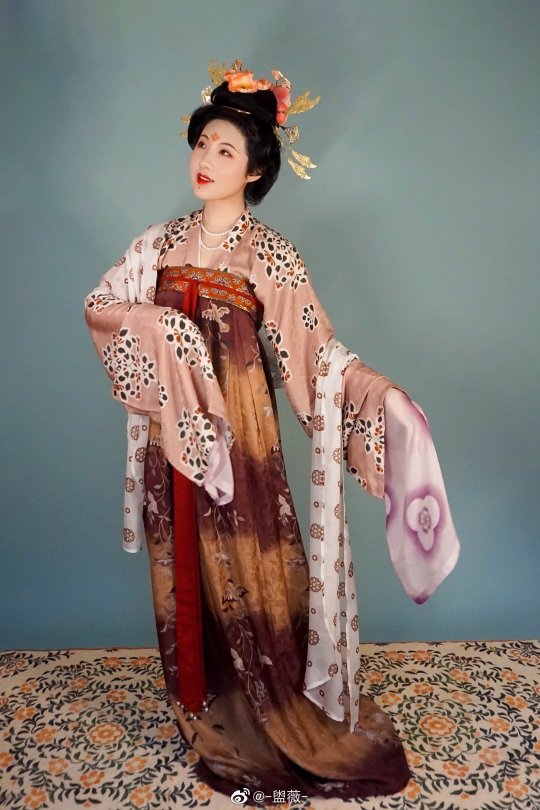






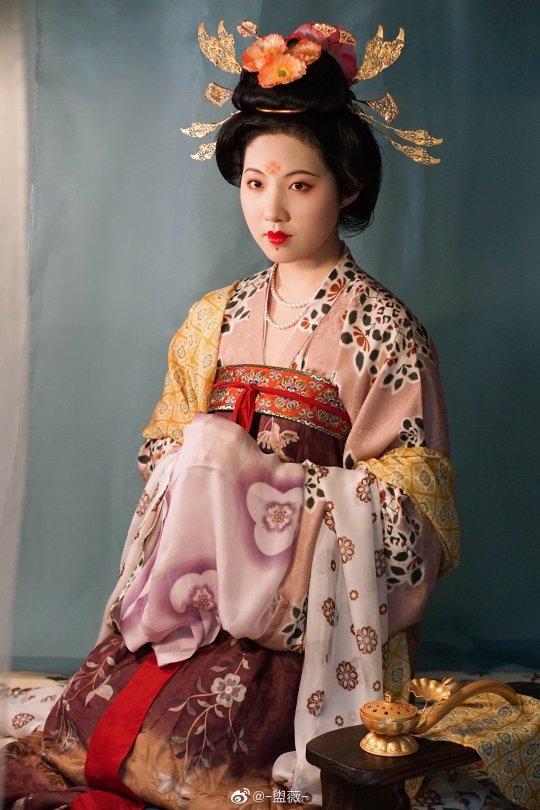
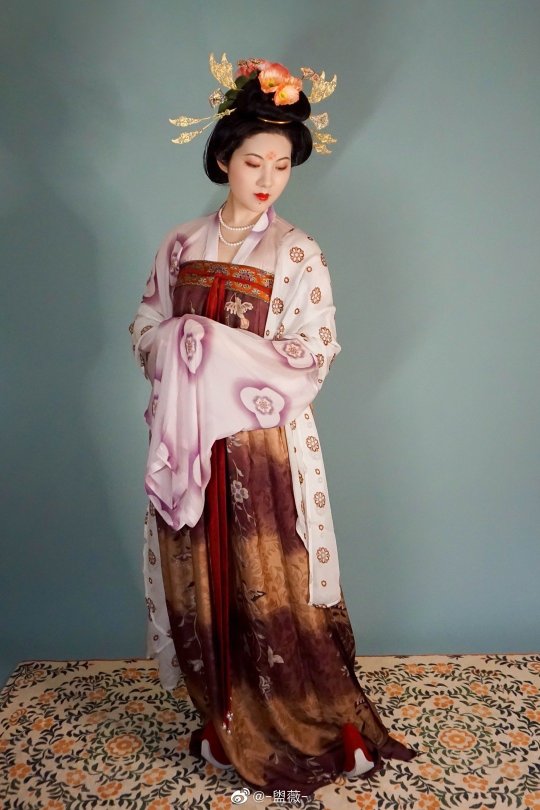

【Historical Artifacts Reference】
Skirt Pattern Reference:Tang Dynasty Murals<Mother and Daughter Doner>in Cave 12 of Dunhuang Mogao Grottoes. ※Due to the mural paint has long been oxidized, resulting in color differences※
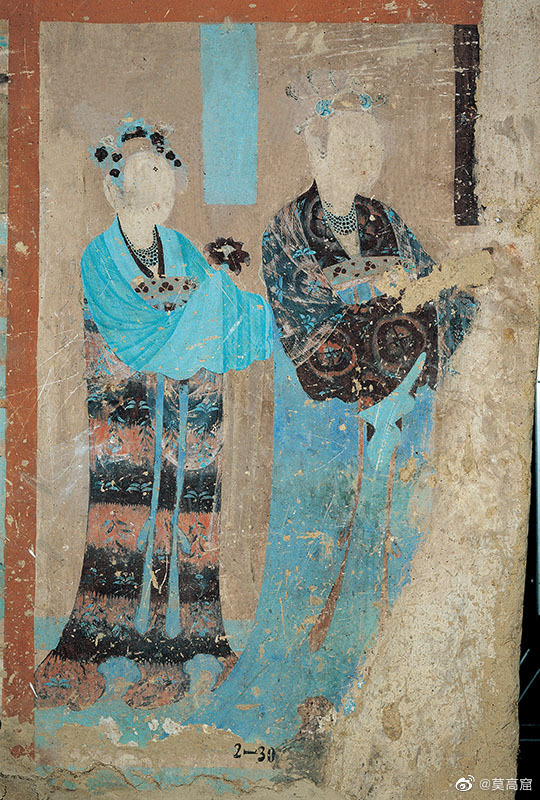
【Skirt Restoriation And Way Of Wearing Reference】
※Let the inner skirt show through the side※
China Five Dynasties and Ten Kingdoms Period:Murals From Tomb of Wang Chuzhi王處直(862–922)
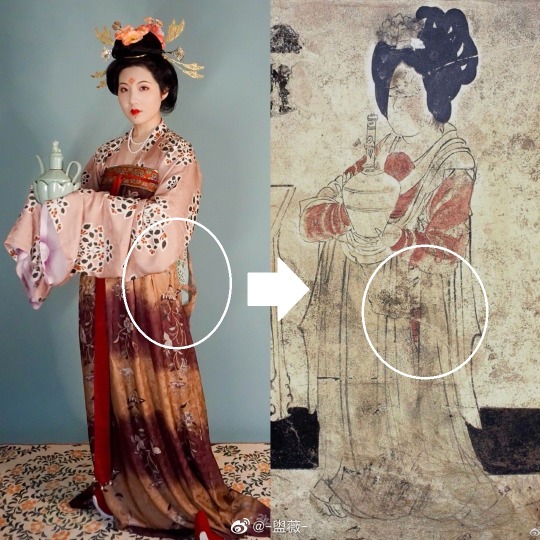
China Tang Dynasty Murals in Cave 159 of Dunhuang Mogao Grottoes.


【Tang Dynasty Hairpin Artifacts】


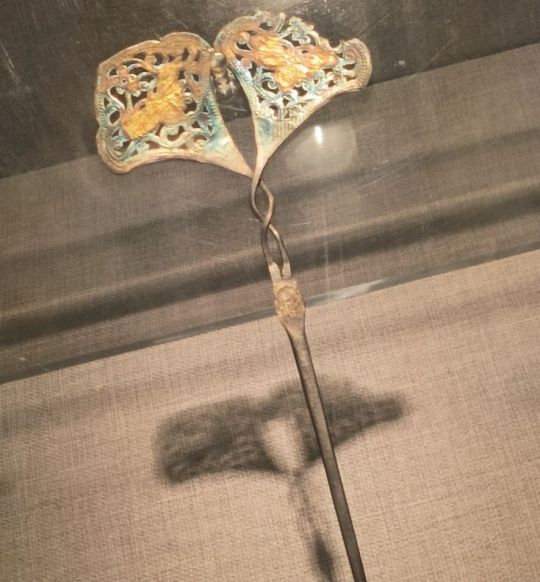


[Hanfu · 漢服]Chinese Tang Dynasty(618-907A.D)Traditional Clothing Refer to Tang Dynasty Dunhuang Mogao Grottoes Murals
Mid-Late Tang Dynasty Women's Attire
————————
📸Recreation Work:@-盥薇-
👗 Hanfu: @时合岁初传统服饰
🔗Weibo:https://weibo.com/3942003133/MC5n4viSt
————————
#Chinese Hanfu#Tang Dynasty(618-907A.D)#hanfu#chinese traditional clothing#chinese history#Mid-Late Tang Dynasty Period#hanfu history#chinese fashion history#ruqun#齊胸衫裙 qixiong shanqun#pibo 披帛#Chinese Culture#china#chinese#Huadian(花钿)#hanfu accessories#hanfu artifacts#Dunhuang Mogao Grottoes Cave#漢服#汉服#recreation#-盥薇-#时合岁初传统服饰#Tang Dynasty Hairpin Unearthed from the tomb of Wu King Wife Tomb#tang dynasty hairpin
236 notes
·
View notes
Text
Okay expanding on something I was going to put in the tags but it drives me nuts when people say "ancient tang dynasty China."
There's a few reasons for this:
The Tang dynasty began in 618 CE, which even if we're only looking at western historical periodization is arguably the very tail end of late antiquity. Calling the WHOLE DYNASTY ancient because it begins in the end of what the west calls "ancient" feels silly.
It ends in 907 CE, which again, by western periodization is explicitly medieval.
Using western European historical periodization for Chinese history is dumb.
Chinese academic studies typically group these periods differently from the western periods. In English language journals, the Tang studies society journal actually includes the Sui (581 CE), Tang, and Five Dynasties periods. (Basically ending just before 1000 CE.) The journal of Song-Yuan studies actually includes "Song, Liao, Jin, Xia, and Yuan dynasties," and covers "middle period China."
You might say "oh medieval is a middle period! So obviously what comes before medieval is ancient, and therefore the tang dynasty is ancient."
But the journal "Early China" covers "all aspects of the culture and civilization of China from earliest times through the end of the Han dynasty period (CE 220)." Meaning that anything post-Han dynasty isn't ancient enough to be included in the ancient China journal.
It's probably MORE Accurate to say that Sui-Tang China is their equivalent to the "Early Middle Ages" and Song-Yuan is the "High Middle Ages." And we just call the Song-Yuan period "middle China". Lots of historians call tang dynasty "early medieval" for a reason!
"but it could be late antiquity, which is still ancient!" But late antiquity is defined in relationship to the remains of the ancient Roman empire which is incidentally, not near China.
My classical Chinese translation class focused on reading ancient Chinese didn't include anything from the tang dynasty because you need to be familiar with ancient Chinese before you get to tang literature
I'm a medievalist
13 notes
·
View notes
Text
April 14, Xi'an, China, Shaanxi History Museum, Qin and Han Dynasties Branch (Part 3 – Innovations and Philosophies):
(Edit: sorry this post came out so late, I got hit by the truck named life and had to get some rest, and this post in itself took some effort to research. But anyway it's finally up, please enjoy!)
A little background first, because this naming might lead to some confusions.....when you see location adjectives like "eastern", "western", "northern", "southern" added to the front of Zhou dynasty, Han dynasty, Song dynasty, and Jin/晋 dynasty, it just means the location of the capital city has changed. For example Han dynasty had its capital at Chang'an (Xi'an today) in the beginning, but after the very brief but not officially recognized "Xin dynasty" (9 - 23 AD; not officially recognized in traditional Chinese historiography, it's usually seen as a part of Han dynasty), Luoyang became the new capital. Because Chang'an is geographically to the west of Luoyang, the Han dynasty pre-Xin is called Western Han dynasty (202 BC - 8 AD), and the Han dynasty post-Xin is called Eastern Han dynasty (25 - 220 AD). As you can see here, in these cases this sort of adjective is simply used to indicate different time periods in the same dynasty.
Model of a dragonbone water lift/龙骨水车, Eastern Han dynasty. This is mainly used to push water up to higher elevations for the purpose of irrigation:
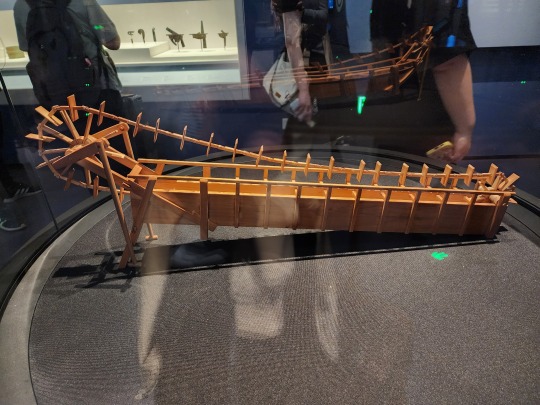
Model of a water-powered bellows/冶铁水排, Eastern Han dynasty. Just as the name implies, as flowing water pushes the water wheel around, the parts connected to the axle will pull and push on the bellows alternately, delivering more air to the furnace for the purpose of casting iron.
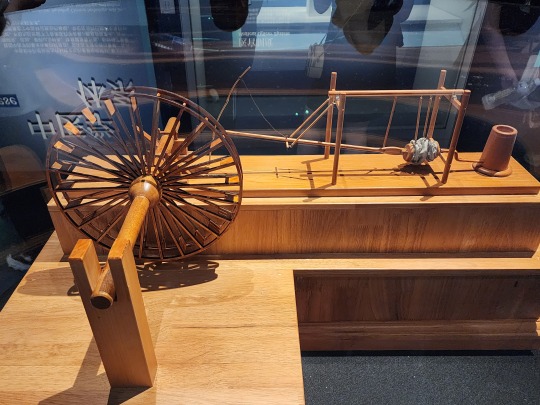
The Nine Chapters on the Mathematical Art/《九章算术》, Fangcheng/方程 chapter. It’s a compilation of the work of many scholars from 10 th century BC until 2 nd century AD, and while the earliest authors are unknown, it has been edited and supplemented by known scholars during Western Han dynasty (also when the final version of this book was compiled), then commented on by scholars during Three Kingdoms period (Kingdom of Wei) and Tang dynasty. The final version contains 246 example problems and solutions that focus on practical applications, for example measuring land, surveying land, construction, trading, and distributing taxes. This focus on practicality is because it has been used as a textbook to train civil servants. Note that during Han dynasty, fangcheng means the method of solving systems of linear equations; today, fangcheng simply means equation. For anyone who wants to know a little more about this book and math in ancient China, here’s an article about it. (link goes to pdf)

Diagram of a circle in a right triangle (called “勾股容圆” in Chinese), from the book Ceyuan Haijing/《测圆海镜》 by Yuan-era mathematician Li Ye/李冶 (his name was originally Li Zhi/李治) in 1248. Note that Pythagorean Theorem was known by the name Gougu Theorem/勾股定理 in ancient China, where gou/勾 and gu/股 mean the shorter and longer legs of the right triangle respectively, and the hypotenuse is named xian/弦 (unlike what the above linked article suggests, this naming has more to do with the ancient Chinese percussion instrument qing/磬, which is shaped similar to a right triangle). Gougu Theorem was recorded in the ancient Chinese mathematical work Zhoubi Suanjing/《周髀算经》, and the name Gougu Theorem is still used in China today.
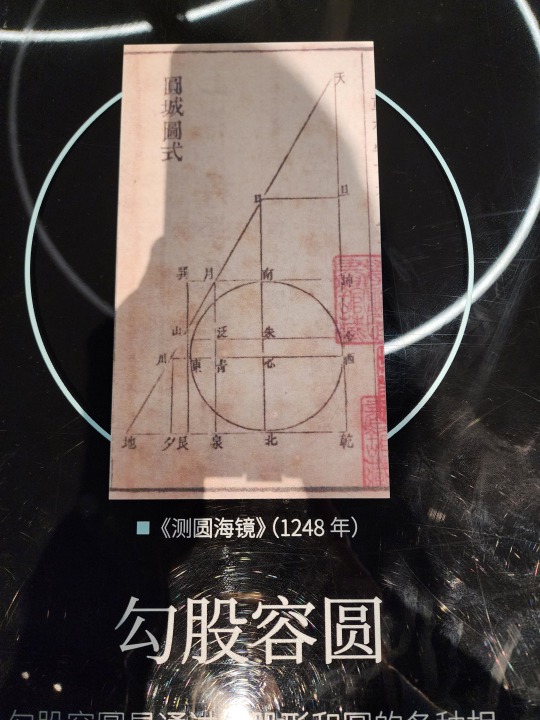
Diagram of the proof for Gougu Theorem in Zhoubi Suanjing. The sentence on the left translates to "gou (shorter leg) squared and gu (longer leg) squared makes up xian (hypotenuse) squared", which is basically the equation a² + b² = c². Note that the character for "squared" here (mi/幂) means "power" today.

This is a diagram of Zhang Heng’s seismoscope, called houfeng didong yi/候风地动仪 (lit. “instrument that measures the winds and the movements of the earth”). It was invented during Eastern Han dynasty, but no artifact of houfeng didong yi has been discovered yet, this is presumably due to constant wars at the end of Eastern Han dynasty. All models and diagrams that exist right now are what historians and seismologists think it should look like based on descriptions from Eastern Han dynasty. This diagram is based on the most popular model by Wang Zhenduo that has an inverted column at the center, but this model has been widely criticized for its ability to actually detect earthquakes. A newer model that came out in 2005 with a swinging column pendulum in the center has shown the ability to detect earthquakes, but has yet to demonstrate ability to reliably detect the direction where the waves originate, and is also inconsistent with the descriptions recorded in ancient texts. What houfeng didong yi really looks like and how it really works remains a mystery.
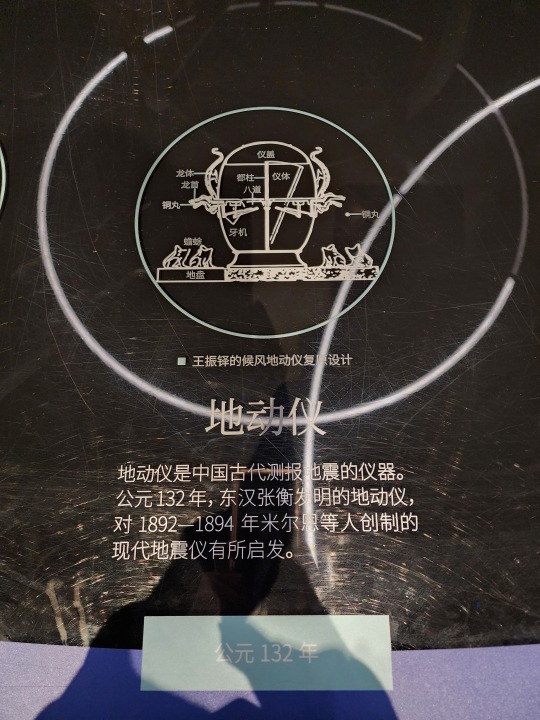
Xin dynasty bronze calipers, the earliest sliding caliper found as of now (not the earliest caliper btw). This diagram is the line drawing of the actual artifact (right).


Ancient Chinese "Jacquard" loom (called 提花机 or simply 花机 in Chinese, lit. "raise pattern machine"), which first appeared no later than 1st century BC. The illustration here is from the Ming-era (1368 - 1644) encyclopedia Tiangong Kaiwu/《天工开物》. Basically it's a giant loom operated by two people, the person below is the weaver, and the person sitting atop is the one who controls which warp threads should be lifted at what time (all already determined at the designing stage before any weaving begins), which creates patterns woven into the fabric. Here is a video that briefly shows how this type of loom works (start from around 1:00). For Hanfu lovers, this is how zhuanghua/妆花 fabric used to be woven, and how traditional silk fabrics like yunjin/云锦 continue to be woven. Because it is so labor intensive, real jacquard silk brocade woven this way are extremely expensive, so the vast majority of zhuanghua hanfu on the market are made from machine woven synthetic materials.

Chinese purple is a synthetic pigment with the chemical formula BaCuSi2O6. There's also a Chinese blue pigment. If anyone is interested in the chemistry of these two compounds, here's a paper on the topic. (link goes to pdf)

A list of common colors used in Qin and Han dynasties and the pigments involved. White pigment comes from chalk, lead compounds, and powdered sea shells; green pigment comes from malachite mineral; blue pigment usually comes from azurite mineral; black comes from pine soot and graphite; red comes from cinnabar; ochre comes from hematite; and yellow comes from realgar and orpiment minerals.

Also here are names of different colors and shades during Han dynasty. It's worth noting that qing/青 can mean green (ex: 青草, "green grass"), blue (ex: 青天, "blue sky"), any shade between green and blue, or even black (ex: 青丝, "black hair") in ancient Chinese depending on the context. Today 青 can mean green, blue, and everything in between.

Western Han-era bronze lamp shaped like a goose holding a fish in its beak. This lamp is interesting as the whole thing is hollow, so the smoke from the fire in the lamp (the fish shaped part) will go up into the neck of the goose, then go down into the body of the goose where there's water to catch the smoke, this way the smoke will not be released to the surrounding environment. There are also other lamps from around the same time designed like this, for example the famous gilt bronze lamp that's shaped like a kneeling person holding a lamp.


Part of a Qin-era (?) clay drainage pipe system:

A list of canals that was dug during Warring States period, Qin dynasty, and pre-Emperor Wu of Han Han dynasty (475 - 141 BC). Their purposes vary from transportation to irrigation. The name of the first canal on the list, Hong Gou/鸿沟, has already become a word in Chinese language, a metaphor for a clear separation that cannot be crossed (ex: 不可逾越的鸿沟, meaning "a gulf that cannot be crossed").

Han-era wooden boat. This boat is special in that its construction has clear inspirations from the ancient Romans, another indication of the amount of information exchange that took place along the Silk Road:

A model that shows how the Great Wall was constructed in Qin dynasty. Laborers would use bamboo to construct a scaffold (bamboo scaffolding is still used in construction today btw, though it's being gradually phased out) so people and materials (stone bricks and dirt) can get up onto the wall. Then the dirt in the middle of the wall would be compressed into rammed earth, called hangtu/夯土. A layer of stone bricks may be added to the outside of the hangtu wall to protect it from the elements. This was also the method of construction for many city walls in ancient China.

A list of the schools of thought that existed during Warring States period, their most influential figures, their scholars, and their most famous works. These include Confucianism (called Ru Jia/儒家 in Chinese; usually the suffix "家" at the end denotes a school of thought, not a religion; the suffix "教" is that one that denotes a religion), Daoism/道家, Legalism (Fa Jia/法家), Mohism/墨家, etc.

The "Five Classics" (五经) in the "Four Books and Five Classics" (四书五经) associated with the Confucian tradition, they are Shijing/《诗经》 (Classic of Poetry), Yijing/《易经》 (also known as I Ching), Shangshu/《尚书》 (Classic of History), Liji/《礼记》 (Book of Rites), and Chunqiu/《春秋》 (Spring and Autumn Annals). The "Four Books" (四书) are Daxue/《大学》 (Great Learning), Zhongyong/《中庸》 (Doctrine of the Mean), Lunyu/《论语》 (Analects), and Mengzi/《孟子》 (known as Mencius).

And finally the souvenir shop! Here's a Chinese chess (xiangqi/象棋) set where the pieces are fashioned like Western chess, in that they actually look like the things they are supposed to represent, compared to traditional Chinese chess pieces where each one is just a round wooden piece with the Chinese character for the piece on top:

A blind box set of small figurines that are supposed to mimic Shang and Zhou era animal-shaped bronze vessels. Fun fact, in Shang dynasty people revered owls, and there was a female general named Fu Hao/妇好 who was buried with an owl-shaped bronze vessel, so that's why this set has three different owls (top left, top right, and middle). I got one of these owls (I love birds so yay!)


And that concludes the museums I visited while in Xi'an!
#2024 china#xi'an#china#shaanxi history museum qin and han dynasties branch#chinese history#chinese culture#chinese language#qin dynasty#han dynasty#warring states period#chinese philosophy#ancient technology#math history#history#culture#language
90 notes
·
View notes
Text
Selections from Hongmei Sun’s “Transforming Monkey”
Here it is! My compilation of quotes that I particularly liked from Sun’s excellent overview of the figure of the Monkey King. I hope you all enjoy them and find that they give you a richer understanding of an amazing text and its amazing monkey
---
Sun, Hongmei. Transforming Monkey: Adaptation & Representation of a Chinese Epic. Seattle: University of Washington Press, 2018.
3: “Sun Wukong, known as the Monkey King in English, is the protagonist of the Ming dynasty novel Journey to the West (Xiyou ji). He is famous for his ability to shape-shift and ride the clouds, his size-changing magic rod, and his love of playing tricks. The longevity of his story reflects his popularity in Chinese culture: the ‘Journey to the West’ narrative is among the most malleable and long-lasting in Chinese literary history. With the repeated adaptations of the narrative over the centuries, the image of the protean monkey character has evolved into the Monkey King we know today.
Journey to the West is a one-hundred-chapter novel published in the sixteenth century during the late-Ming period. It is considered one of the four masterworks of the Ming novel, along with Water Margin (Shuihu zhuan), Romance of the Three Kingdoms (Sanguo yanyi), and The Plum in the Golden Vase (Jinping mei). Loosely based on the historical journey of the famous monk Xuanzang (602-664), who traveled in the Tang dynasty from China to India in search of Buddhist scriptures, the story experienced a series of adaptations over hundreds of years before it was developed into the full-length novel, which recounts a mythological pilgrimage of the monk Tripitaka (the fictional Xuanzang), accompanied by three disciples and protectors he converts along the way: Sun Wukong (aka the Monkey King, or Monkey), Zhu Bajie (aka Zhu Wuneng, Pigsy, or Pig), and Sha Wujing (aka Sha Seng, Sha Heshang, Friar Sand, or Sandy). These disciples, as well as a dragon prince who transforms into a white horse as Tripitaka’s steed, are demons or animal spirits who have sinned…”
4: “Along the way, the group encounters and overcomes eighty-one tests, most of which involve demons and spirits who want to capture Tripitaka and eat his flesh in order to gain immortality.
The history of Journey to the West represents a process of continuous adaptations of Xuanzang’s story. The historical trip becomes a mythological journey in a world full of demons, spirits, Taoist gods, and Buddhist celestials. At some point—the actual origin and provenance remain unclear—the monkey follower of Xuanxang was added to a retelling of the story. Once included, the monkey figure grew in popularity until he replaced the monk as the main character and protagonist. It is owing to the long process of adaptation that today the Monkey King remains popular globally.”
5: “Literary analyses of the text have taken diverse and heterogeneous approaches but have predominantly focused on the religious and allegorical meanings of the tales. Little has been written about the Monkey King image in contemporary settings from the approach of adaptation, despite the obvious importance of this approach for Journey to the West, which is the product of repeated adaptations and maintains its influence in popular culture through ongoing adaptation today. Journey to the West is an accretive text, shaped by many hands at many times, and through interactions with many audiences.”
6: “…for lack of new data and more convincing interpretation, the Shidetang edition printed in 1592 is generally considered the ‘original.’ Although it is now generally accepted that Wu Cheng’en (ca. 1500-ca. 1582) is the author of the Shidetang edition of Journey to the West, this position is supported only by the lack of better candidates and more convincing evidence. Furthermore, the origin of the Monkey King character remains unclear.”
-“Through hundreds of years the Monkey King figure has shown amazing adaptability. His story appears in various forms in all media, crossing borders of culture and time, and his image has been frequently used in racial and political representations with social and political impact. Sun Wukong’s changes throughout modern history, intertwined with the construction and representation of Chinese identity, require a thorough examination.”
9: “Tracing further back from “Journey to the West,” two major sources for the narrative have been found: the historical journey of Xuanzang and the mythical figure of the Monkey King. Although the historical event clearly refers to the journey to India that the monk Xuanzang undertook in the seventh century, and the historical figure Xuanzang is accepted almost unanimously by scholars as the source of the character Tripitaka in the novel, the source of the Monkey King is unclear. Multiple figures may have influenced the image of the Monkey King, including Hanuman in the Indian tradition and monkey lore in the Chinese tradition. Each of these two major narrative lines revolves around one protagonist, who together become the two major characters in Journey to the West. Although the Monkey King figure was adopted into the narrative of the journey to India as only a helper of the monk, in later versions of the story the monkey becomes the protagonist, as becomes evident in Journey to the West, and more obviously in contemporary adaptations in China, where the Monkey King becomes the central figure with whom the audience identifies, and Tripitaka is portrayed with more negative features.”
11: “If one were to narrow the rich meaning of the Monkey King image down to a trope, it would like in the tension between the monkey, the human, and the god that coexists in the Monkey King. Because the tension exists in something as important and personal as the body itself, the image of Sun Wukong is therefore being used in a varied situations representing the struggle in identity. What the Monkey King can contribute to the issue of Asian American identity is the metaphor of transformation, the freedom one can attain in one’s body, and by extension in aspects of one’s social life.”
13: “Because of the fundamental multivalence in this figure, various political and ethnic groups use him as a representative to tell their own stories…Historically speaking, ‘Journey to the West’ is a product of adaptation. When the image of the Monkey King is added to the narrative and gradually takes the shape of Sun Wukong in Journey to the West, the influence of antecedents and the interlacing traditions of popular and elite culture together shape what we know as the protagonist of the sixteenth-century novel. A major transformation takes place in the mid-twentieth century during the reign of Mao Zedong, when the trickster monkey is collectively recast as a revolutionary hero. This heroic image remains the mainstream view until a new change is initiated by a Stephen Chow film, A Chinese Odyssey (1995), after which the image of Monkey takes a postsocialist turn. While the new transformation of the Monkey King as a hero is ongoing in China, in American popular media the Monkey image is adapted in a different manner, representing a mythical and antiprogressive oriental. Asian American adaptations, on the other hand, use the image of the Monkey King to illustrate the struggles of ethnic minorities in the United States, racial stereotypes, and ethnic identity. Monkey continues to shape-shift in new places and times, and each new Monkey collectively enriches our understanding of his image.”
15: “At the beginning of the hundred-chapter novel Journey to the West, a monkey is born from a primeval stone egg. This uncommon birth makes it impossible to place him into a distinct taxonomic category. ‘Born of the essences of Heaven and Earth,’ he is nonetheless still one of ‘the creatures from the world below.’ While the Monkey King belongs to both heaven and earth, his legendary birthplace is not easily locatable in either. According to the Buddhist cosmology introduced to the reader at the beginning of the first chapter, the Flower-Fruit Mountain (Huaguo Shan) appears to be located on the East Purvavideha Continent (Dong Shengshen Zhou), one of the four continents of the world. However, its geographic location relative to heaven and earth, or to the other continents that the monkey traverses in his journey, is never accounted for. To some extent the ambiguous birth and birthplace of the monkey contribute to his multivalent character.
At home on the Flower-Fruit MMountain, the monkey soon declares himself the Monkey King after demonstrating his prowess by crossing a waterfall and discovering a new territory, the Water-Curtain Cave, on behalf of the entire monkey kingdom. It is the first breakthrough in his life and is accomplished through crossing boundaries. Soon thereafter, and having become dissatisfied with a mortality that, by necessity, would subject him to the border between life and death, the self-proclaimed king sets off on a raft in search of a teacher who might guide him toward immortality. This journey brings him from the East Purvavideha Continent to the West Aparagodaniya Continent (Xi Niuhe Zhou), where he finds a master in the Patriarch Subhuti (Xuputi Zushi) on Lingtai Mountain.”
16: “Of no small significance, the master, one of the ten disciples of the Buddha, is described here as one who finds harmony among Buddhism, Taoism, and Confucianism. By means of the physical and spiritual journey from east to west, the monkey has acquired a name, Sun Wukong (Awaking to Emptiness), together with esoteric techniques enabling him to wield magical powers.
After returning to the Flower-Fruit Mountain, Sun Wukong successfully defends the subjects of his monkey kingdom by defeating a demon foe and thereby creating a name for himself among the demon kings. In addition, he befriends a number of immortal beings who occupy neighboring lands, one of whom in the Bull Demon King (Niumo Wang), who later becomes an antagonist of the pilgrims. By becoming brothers with these demons on earth, Sun Wukong posits himself as one of them. He tests his power in the water realms and convinces the dragon kings there to present him with their treasured magic iron, which becomes hi famous iron rod. He also creatures turmoil in hell when he deletes the names of his monkey tribe from the Register of Life and Death, hence attaining immortality, although unofficially. The sphere in which he can be active is thus enlarged to include the earth, the sea, and the underworld.
Heaven, having learned of the monkey’s mischievous behavior, appoints him as Supervisor of the Imperial Stables (Bimawen), in an effort to co-opt him. His territory is thus further enlarged to include heaven. This is an important step in his life since he is now recognized as a deity within the heavenly hierarchical system rather than an outsider demon. When Sun Wukong recognizes his low position in the celestial hierarchy, he returns to his mountain and lays claim to the title ‘Great Sage, Equal to Heaven,’ essentially declaring himself the strongest demon in the world in possession of an outlaw power on par with heaven’s. Dissatisfied with marginalization within one system, he simply chooses to create a parallel system and names himself its head. And when heaven is unable to take him by force, it once again must reabsorb the monkey peacefully by reaccepting him into the heavenly fold. Despite being officially recognized as the Great Sage, the Monkey King still constantly breaks rules in heaven, and ultimately creates havoc when he learns he is not invited to the Peach Banquet. The disgruntled monkey breaks off yet again from heaven, this time demanding that he replace the Jade Emperor…”
17 + 18 (for list): “…himself. Significantly, the domains that Sun Wukong has so far tested and conquered include the earth, water, hell, and the Taoist heaven. Being active in all levels of the mythic cosmos enables him to enjoy immense growth in his realm—but more importantly, he becomes effectively limitless.”
Sun Wukong’s rebellion comes to an end when he meets the Buddha. He accepts the wager the Buddha has proposed, which is to jump out from the Buddha’s palm. Failing to do so, since the Buddha’s palm can grow as fast as Wukong can jump, he is subsequently imprisoned under the Five Phases Mountain for five hundred years, which functions as a turning point in Monkey’s life and an intermission in the narrative. What Monkey goes through during this period is completely omitted by the narrative, which simply switches to the story of Tripitaka and the beginning of the journey. When the Monkey King reappears in the story, his life starts anew on a very different track.
The monkey is in due course released by the traveling monk Tripitaka, who becomes his master and gives him the name Pilgrim (Xingzhe). At the beginning the master is shocked by Wukong’s demonic behavior and worried that the monkey might be out of control. The Bodhisattva Guanyin responds by setting a fillet on the monkey’s head. The tightening of this band—in response to Tripitaka’s recitation of the Tight-Fillet Spell (Jingu Zhou)—enables Tripitaka to control the monkey’s actions. Henceforth Sun Wukong serves as Tripitaka’s protector and as leader of the other disciples. He becomes the monk’s most reliable defense against demons and monsters on their way to the West. In the following eighty-seven chapters, which are primarily a long series of captures and releases of the pilgrims by monsters, demons, animal spirits, and gods in disguise, Sun Wukong either defeats the adversaries himself or finds a natural or sociopolitical conqueror of the enemy to ensure victory.
In Journey to the West, Monkey’s life can be summarized as composed of two parts, with the Five Phases Mountain as the watershed. Before his subjugation by the Buddha under the Five Phases Mountain, his life can also be divided into several phases, each phase with a different name and identity:
I: Before Subjugation:
a. The nameless stone monkey
b. The Handsome Monkey King (Mei Houwang)
c. Sun Wukong (name given by Subhuti)
d. The Supervisor of the Imperial Stables (Bimawen)
e. The Great Sage, Equal to Heaven (Qitian Dasheng)
Intermission: 500 years under the Five Phases Mountain
II: After Subjugation
Pilgrim (Xingzhe)
18: “The five phases of the monkey’s life before his subjugation by the Buddha demonstrate the innate drive of the monkey to test every limit that defines his sphere. With each step the monkey takes in his life, there is a transformation, a breakthrough, and his magic skills allow him to transgress limits. Step by step he broadens his sphere, challenging every authority, until he is facing the greatest cosmic power (who is, interestingly, the foreign Buddha from the West, invited by the indigenous god, the Jade Emperor). It is the spirit that challenges all limits that identifies him as a demon, one of those who dwell outside of the space of heavenly order. Since hierarchical control is about keeping boundaries and maintaining order, this kind of nonstop challenge cannot be accepted. Monkey therefore has to be either considered as a challenge from the outside (a demon) or changed and co-opted within the system.”
--“The five hundred years serve as a narrative gutter, before which Monkey strives to surpass all boundaries—the patriarch of all beings—while after it the monkey becomes a servant, a pilgrim following the orders of a monk, confined by the magic headband. Before the gutter, he was a demon himself; after the gutter, he becomes a demon-subjugator and a demon killer. When encountering and fighting antagonist demons, the pilgrim monkey continually boasts to them about his glorious past as a demon monkey but the kills or subjugates them by himself or with celestial help. In this sense, the journey of the pilgrims is at the same time a story of demon-conquering and an account of the subjugation of the monkey himself.”
19: “He is simultaneously the one and the other, dual contradictions within one body.
But this is not only a journey from China to India. The Monkey King’s journey, far from unidirectional, is also full of upward and downward movement—he bounces between the heavenly gods and the demons and monsters on earth both before and after his submission. The nature of these trips does, however, change after his imprisonment. In the early phases of his life, the journeys up and down are carried out via his free will, whereas the later ups and downs as a pilgrim are mostly arranged by Guanyin and the other gods, as part of the trials of the journey. Just as his somersault never enables him to jump out of the hand of Buddha, his somersaulting up and down during the pilgrimage never gets him out of the determined trajectory of his life. He is only fulfilling his task, the mission of a pilgrim who works as a mediator.
The character of the Monkey King is fundamentally self-contradictory. In the earlier stage of his life, his is a self-important heroic rebel, but later he transforms into a loyal disciple of the monk master and a pious believer in Buddhist thought. Monkey does go through some transitional periods during the journey, including a few incidents in which he is in disagreement with, yet has to obey, Tripitaka, but later in the journey the narrative demonstrates that his understanding of the Heart Sutra often even surpasses that of Tripitaka.”
20: “Reflected by his names and titles, Sun Wukong juggles his multiple identities, some of which are sharply opposed to each other.”
21: “Rather than mediating between two opposite states, the Monkey King denies and deletes dualism and brings multiple and otherwise incompatible possibilities together.”
24: “As a narrative rejecting dichotomy, Journey to the West clearly rejects a simple division of the story into shouxin (controlling the mind, retrieving of mind) and fangxin (letting the mind go, exile of the mind). Not only is the ‘mind monkey’ always fond of his mischievous ways when he remains a follower of Tripitaka, in the two episodes of the ‘exile’ of the ‘mind monkey,’ he is never totally let loose either. In both cases he asks Tripitaka or Bodhisattva to take his head fillet off, but neither of them is able to fulfill his request. Ironically, although Tripitaka ‘exiles’ the monkey from the pilgrim group, his power over the Tightening Fillet remains. Monkey, on the other hand, is also never totally happy when being released. In the case of the first release, Bajie (Pigsy) has to resort to a stratagem to persuade the monkey to return: he lies to the monkey that the monster who had beaten the pilgrims does not take seriously of the name of Sun Wukong and his deeds in heaven five hundred years ago. It is in defense of his reputation as the ‘number one monster’ that the monkey leaves his Flower-Fruit Mountain and returns to rejoin the band of pilgrims.
In the case of the second ‘exile,’ the episode of the ‘double-mind monkey’ (erxin yuan), a fake Wukong commits a series of monstrous crimes in his name. While one ‘mind monkey’ is staking with the Bodhisattva, the other ‘mind monkey’ goes to strike the master Tripitaka unconscious, takes his travel documents, returns to the Flower-Fruit Mountain, and sets up another pilgrim band, ready for his own journey to the West. The resemblance of the two ‘mind monkeys’ deceives everyone except the Buddha, who sees through the fake Wukong and recognizes him as a six-eared macaque (liuer mihou). The use of a double of Wukong enables the narrative to literally grant the monkey the facility to be self-contradictory, with one Monkey being a pious follower of Tripitaka, and the other a monster who is even capable of beating his master. At the culmination of this episode, Sun Wukong uses his rod to kill the six-eared macaque,…”
25: “…despite the fact that the macaque had already been captured by Buddha’s golden almsbowl—a constraining weapon—and submitted to Buddha’s control, which seems out of character for the ‘good’ Monkey. One feasible explanation would be that it is an action of eliminating the monster in him, indicating that he is getting closer to achieving Buddhahood at this point in the journey. However, this explanation does not negate another one: that he kills the six-eared macaque because the latter has copied him too closely, the best demon among the ones that Monkey has conquered. By killing his rival who resembles himself, he plays the norm of self-contradiction to an extreme.”
26: “At that very moment the actual smallness of the monkey’s bloated self is demonstrated in the shadow of the Buddha’s fingers, the overblown ‘mind monkey’ is reduced to finite proportions, and his rehabilitative imprisonment under Five Phases Mountain begins. The lesson demonstrates to him that, however far the ‘cloud-somersault’ can reach, it would also represent his own unbreakable boundary. The Buddha’s fingers serve as an index, revealing to the monkey that what beats him is how own self. Later this indexing role of Buddha’s hand is taken over by the Five Phases Mountain, and after that the headband. Whenever Tripitaka recites the spell, Monkey is reminded of his own limits and the impossibility of breaking them, even with his rod.
In the case of the six-eared macaque, one can reach an opposite explanation as to why Wukong chooses to kill him: to free himself. Just as in the submission of Wukong, Buddha beats the six-eared macaque at his forte. Although the fake Wukong is strong in taking forms of others and had succeeded in confusing everyone else, the Buddha is able to exactly identify this monkey’s original form: someone belonging to none of the ten categories in the universe, neither the five immortals (wu xian) nor the five creatures (wu chong). There are four kinds of monkeys who ‘are not classified in the ten species, nor are the contained in the names between Heaven and Earth,’ among which was the first, ‘the intelligent stone monkey (lingming shihou), who knows transformations, recognizes the seasons, discerns the advantages of earth, and is able to alter the course of planets and stars,’ and the fourth, ‘the six-eared macaque, who has a sensitive ear, discernment of fundamental principles, knowledge of past and future, and comprehension of all things.’ This recognition announces the six-eared macaque’s failure as one who has been trying to use his disguise to erase the boundary of his self while taking up the identity of Wukong. It also announces once again the failure of Wukong, who although not belonging to any of the ten species between heaven and earth, still falls into one of the in-between types that the Buddha names: the intelligent stone monkey, indeed a peer of the six-eared macaque. Therefore by killing the six-eared macaque, Wukong not only kills a monster who has tried to cross proper borders, but he also kills a self whose boundary has just been pinned down. This action of self-annihilation is in this sense an effort in defiance of any classification.”
27: “Readers may often find it hard to tell whether the monkey is a monster or a pilgrim during any one incident: just like the rod and headband, the monster and pilgrim are indispensable sides of the character of Sun Wukong.”
-“The narrative of Journey to the West itself also has a multivalent nature. Containing and allowing for contradictions is a central message of the book. Theses and rhetoric of Buddhism, Taoism, and Confucianism all appear in every part of the work. For a story of Buddhist monks’ pilgrimage for Buddhist sutras, it also bears apparent characteristics of Taoist dual cultivation. While gods of Buddhist and Taoist traditions happily coexist, a Confucian emphasis on filial piety and loyalty is also prevalent. Owing to the coexistence of heterogenous factors, the text gives space for various interpretations of the metaphorical meaning of the book…In the narrative there are multiple parameters for the classification and ranking of cosmic beings, among them two basic categories—the earthly demons and the heavenly gods. At first glance the two are a pair of opposing powers, one always contradicting the other. However, a closer view of the relationship between the two reveals that the boundaries between the categories and kinds in the cosmic hierarchy are not firmly fixed. There are always possibilities of crossing the boundaries; the coexistence of all these distinctive beings is already an act of the abnegation of boundaries.”
28: “Historian of Chinese religion Robert Campany visualizes the positions of these demons in the hierarchy, within which boundaries can be crossed upward or downward by means of transformation (hua, the phenomenon of demons assuming bodies and forms not their own), reincarnation, cultivation, conversion, or subjugation. Hierarchical distinctions are thus relative, and typological divisions appear to be mere illusion, with the pilgrim and demons both functioning as antagonists and complementing one another. Although demons and the pilgrims are similar in that both strive for cultivation of self, ‘demons have not yet realized the necessity of submitting the self to a larger Self that is the entire cosmic order.’ This insight points to another duality that is undercut by the narrative.
This allegorical explanation—that the pilgrims, by battling against the demons, come to realize the truth of emptiness, while Wukong, as indicated by his name, has always been aware of it—however, is too neat, as the purpose of the journey allows to multiple interpretations. While the pilgrims are moving toward a destination, ironic tension is apparent between the exuberant ease with which Monkey travels between different sphere and Tripitaka’s extreme difficulty in moving forward on his journey on earth.”
29: Andrew Plaks argues that “the characteristic Chinese solution to the problem of duality ‘consists in the conception of a universe with neither beginning nor end, neither eschatological nor teleological purpose, within which all of the conceivable opposites of sensory and intellectual experience are contained, such that the poles of duality emerge as complementary within the intelligibility of the whole.’ This argument about the Chinese concept of complementary duality provides an interesting explanation for the coexistence of contradictions in the narrative. It may also count as one of the cultural situation ‘generative of ambivalence and contradiction’ that folklorist Laura Makarius discusses. The concept of complementary duality in Chinese culture certainly helps explain the fundamental ambiguity regarding the teachings in the journey, the most famous being the merging boundary between god and demon.”
-“Transformation is something practiced very commonly by heavenly immortals and demons alike in Journey to the West. Besides crossing the boundary between the deity and demon, it also illustrates that all ‘forms,’ no matter how different they might look, are the same because they are all manifestations, or illusions. Forms are not the true nature of a being, and an important technique for a creature to attain in becoming an immortal through cultivation is the ability to transform itself, as well as the ability to see through forms. The Monkey King is among the most adept at seeing through the false forms of demons and monsters. In short, transformation, and the understanding of transformation, seem to have a crucial connection with a nondualist (or multivalent) understanding of the universe.”
35: “The multistable image of the Monkey King…serves as a hyper-icon. The seemingly simple factors of the image, a monkey in human clothes with a head ring and an iron rod, together encapsulate a whole bundle of meanings, an entire episteme. It can be used as a decoration, and it can also be used to speak to power, knowledge, and representation. It is fascinating that it continues over centuries to appeal to readers/audiences of various social orders and successfully transforms them into creators of new images.”
39: “Shihua [Full title Da Tang Sanzang qujing shihua] is the first fictional account of Xuanzang’s journey in which the monk acquires a monkey attendant who functions as his guide and protector. Following his introduction, the monkey figures enjoyed growing popularity in subsequent fictional retellings of the story, until in the hundred-chapter novel Journey to the West he becomes the protagonist of the story, overshadowing his master…Compared to Xuanzang’s historical journey, Shihua introduces two major changes to the nature of the journey that are carried through later adaptations of the story. In the first, the monk’s individual religious pursuit, a brave act that breaches the law of Tang and puts his own life at risk, is transformed into the performance of a decreed commission from the Tang emperor. Although the imperial decree seems to have given Tripitaka a more celebrated status, his choice to defy the legal order in order to undertake his religious pilgrimage is taken away from the monk. Second, realistic challenges the monk had to face are replaced by obstacles deployed by demons and deities, which Tripitaka relies on the monkey to conquer. These two changes set the stage for a transformation of the story about Tripitaka into a story about the monkey.
Buddhist themes and elements in the story are obvious, but there is no monopoly of Buddhist themes; instead, a variety of traditions and cults are present in the text, with popular tradition being blended into the orthodox religious material. In this sense, Shihua already begins to show what is masterfully realized in the hundred-chapter version Journey to the West: the encyclopedic coexistence of different and conflicting cultures and traditions. According to Shihua’s account, the monk is on his way to acquire scriptures because he has received an imperial commission. On his way he meets the monkey figure, Hou Xingzhe (Monkey Acolyte), who becomes his guide and assistant. This story is filled with praises of the religious pilgrimage, paying its respects to Buddha and Buddhist teaching and eulogizing the peaceful places near the Western Heaven. Unlike the later versions, it is clear in the story that the success of the pilgrimage is based on Tripitaka’s deep understanding of Buddhist texts and great strength in his belief. The Tripitaka in later versions will reply on the assistance of Sun Wukong and gods from all parts of the universe to complete his journey.”
40: “There is little evidence to show where the monkey figure originated, but scholars have discussed the possible connections between Hou Xingzhe and the carved monkey figures at the Kaiyuan Temple in Quanzhou Prefecture, Fujian; monkey stories in Buddhist texts; and Hanuman of the Ramayana. Discussion about Hanuman as the influence or origin of Sun Wukong can be traced to Hu Shih’s 1923 article ‘Textual Criticism of Journey to the West’ (Xiyou ji kaozheng), but at about the same time Lu Xun, in his Brief History of the Chinese Novel (Zhongguo xiaoshuo shilue), disagreed, connecting Sun Wukong with the ape-shaped Chinese mythical figure Wuzhiqi. The two scholars who built the foundation of modern Chinese literary study thus began a long-running argument in Journey to the West scholarship about the origination of Sun Wukong. Even today, the problem of the origin of the Chinese Monkey King is unresolved. For, in addition to these two sources, there are other possible origins or influences, such as the influence of Buddhist texts; the figure of Shi Pantuo, a disciple of Xuanzang at the beginning stages of his trip; the Monk Wukong of the Tang; tales about a white ape who abducts women; and the Fujian cult of Qitian Dasheng or Tongtian Dasheng….Regarding the origination of Hou Xingzhe, Zhang Chengjian’s findings generally support the notion of a greater influence from India than from indigenous myths, and in particular the influence of Hanuman or the ape-shaped guardian general in the Tantric tradition.”
41: However, “scholars who support this view have not been able to provide a convincing theory about the paths of transmission of the Hanuman story. It would seem that the Ramayana may have been transmitted to and spread in China via the Silk Road, the marine Silk Road, or the path via Schuan and Yunnan; however, these paths do not correspond with the appearance of Hou Zingzhe and the transmission of Hanuman to China in either time or place…a foruth path for the transmission of Hanuman could be the Musk Road via Tibet, , as the Tantric tradition reflected in Shihua and the spread of Tantric Buddhism at the time from India through Tibet to China demonstrates a connection between Hanuman and Hou Zingzhe. It is worth noting here, though, that the necessary link between the transmission of Tantric Buddhism and the story of Hanuman is yet to be found. Nonetheless, the image of Hou Xingzhe in Shihua reminds us more of Hanuman and the images of the monkey protector figures found in mural paintings in Dunhuang and the stone relief in Kaiyuan Temple—these serious and godlike images bear very little resemblance to the trickster that the monkey would become in later version.
The role that Hou Xingzhe plays is Tripitaka’s guide through the journey. Although Xingzhe calls Tripitaka ‘my master’ (wo shi), he is the one who gives advice, and Tripitaka always follows it.”
44: “…although Hou Xingzhe appears as a clearly synthesized figure in Shihua, bearing influences from both Indian and Chinese cultures, he is mostly an honorable and capable godlike figure. Negative features have yet to be developed in this character.”
-The six-part, twenty-four-act Zaju Xiyou ji is attributed to the fourteenth-century playwright Yang Jingxian, who lived during the late Yuan and early Ming periods. In the few hundred years between Shihua and Zaju, the story of ‘Journey to the West’ is not only more expanded, containing many of the stories that can be found later in Journey to the West, but the monkey figure in Zaju has grown into a character strikingly different from Hou Xingzhe. If Hou Xingzhe in Shihua is depicted as an advisor for Tripitaka, as respectable albeit mysterious deity, and a brave fighter, the monkey in Zaju is pictured as a rowdy clown, an untamed demon and ill-qualified Buddhist disciple.
The monkey’s name in Zaju now is almost the same as in the sixteenth-century fiction Journey to the West. He refers to himself as ‘Tongtian Dasheng’ (Great Sage Reaching Heaven), only one word’s difference from ‘Qitian Dasheng,’ the title Sun Wukong receives from the Taoist heaven in the sixteenth-century book. In some versions of the Monkey King story, including the Zaju, Qitian Dasheng and Tongtian Dasheng are brothers…”
45: “Although Tongtian Dasheng is the monkey’s title, in the drama everyone calls him ‘the monkey’ (husun), including Guanyin, even though she is the person who gave him the names Sun Wukong and Sun Xingzhe (Acolyte). When Guanyin presents Sun Xingzhe to Tripitaka as his disciple, she gives the monkey an iron fillet, a cassock, and a knife….Even with the headband’s control, Tongtian Dasheng’s behavior and language indicate that his mind remains that of an irreverent demon.
As in the zaju theater tradition, Sun Xingzhe introduces himself to the audience with a poem at his first appearance. Vaunting his celestial birth, his power, and the troubles he could create, in colloquial expression rather than elegant traditional terms as others’ opening poems, the monkey’s poem describes himself as a celebrated ape demon, referring to himself as the King of a Hundred Thousand Demons. In the following statement he introduces himself and his four siblings as his demon family: His elder brother Quitian Dasheng, a younger brother Shuashua Sanlang, and two sisters, Lishan Laomu and Wu Zhiqi Shengmu. This genealogy of the monkey shows that Sun Xingzhe in Zaju is already much more localized, settled into the local religious/cult culture. Unlike the monkey in other versions, this one has a wife, the abducted princess of the Country off the Golden Cauldron. He also proudly reports to the audience his famous misdeeds, which is also the reason that heaven is after him: he has stolen the Jade Emperor’s celestial wine, Laozi’s golden elixir, and the Queen of the West’s (Xichi Wangmu) peaches and fairy clothes. He also makes upfront ribald references about himself in this very first speech. The monkey’s demonic heart is indicated by his intention to eat Tripitaka immediately after Tripitaka rescues him from beneath the mountain. He never shows any seriousness about his business of pilgrimage, and his behavior does not improve during the journey. When the team arrives in India, he uses crude language in a conversation with an old lady about Buddhis ideas of the ‘heart.’”
46: “Sun Xingzhe does not act seriously, nor does he ever speak seriously. The king of demons seems to be good only at stealing and running away.”
-“In scenes 13-16, in the episode of Tripitaka and Sun Xingzhe’s encounter with Zhu Bajie the pig demon, who is converted into Tripitaka’s second disciple, Xingzhe offers to help fight the pig demon, but he is more interested in the Pei girl (old man Pei’s daughter) who has been abducted by Zhu. He only offers to help after old Pei tells him that his daughter is a rare beauty, and his dealings with the pig only revolve around the girl: when he visits the pig’s mountain home, he sees only the Pei girl, so his first action is to take the girl back to Pei. He then waits fo Zhu Bajie in the bridal chamber in the Pei girl’s clothing and flirts with the pig when he arrives…His sustained interest in woman and sex is demonstrated in another encounter with a demon in the Flaming Mountain episode. In this story, he seeks to borrow the Iron Fan from Princess Iron Fan (Tieshan Gongzhu) to put out the fire,…”
47: “…but because he introduces himself using vulgar language, the princess refuses to lend him the fan and instead attacks him. Although eventually—with the help of Guanyin and other gods—the pilgrims pass the Flaming Mountains, the battle with Princess Iron Fain, which later becomes one of the most famous battles of Journey to the West, seems to be caused solely by Sun Xingzhe’s insolence.”
-“The vulgarity of Sun Xingzhe’s language persists throughout the drama. The zaju drama during the Yuan era is distinguished from most other earlier Chinese art forms by its use of informal, vernacual, and nonsensical language. The language that Xingzhe uses is the most vulgar of all, corresponding to his role as the clown. He amuses by making crude jokes and obscene references at most inappropriate occasions throughout the story. For instance, at a crucial moment of his life when Tripitaka meets him for the first time and tries to climb the mountain to have him released, the monkey starts a conversation about love and explains that Triitaka’s motivation to save him is his lust for the monkey’s thin waistline, which resembles that of a desirable beauty. The monkey makes a reference to Agilawood Pavilion (Chenxiang Ting), a place that is known through Li Bo’s poems about the love affair between Emperor Tang Xuanzong and his consort Yang Guifei.”
-“When asked about his heart, Xingzhe comments that he used to have a heart, but he ‘shit it out’ because his ‘asshole’ is too wide.”
48: “From Shihua to Zaju, the monkey is transformed from a god who acts properly to a demon who uses foul language and makes suggestive jokes. In the hundred-chapter Journey to the West, Sun Wukong is turned into a multivalent figure, funny but not crude. The vulgarity of Sun Wukong seems to be peculiar to the Zaju version.”
53: “If Hou Xingzhe is in general a god with positive qualities, Sun Xingzhe in Zaju shows the negative parts of his character coming into full bloom. He is much more associated with a buffoon and a demonic ape than with a celestial god. From Hou Xingzhe to Sun Xingzhe, the monkey figure is more localized, closely bound with popular culture. If we indeed can consider him as a figure on the way toward his Buddhist belief, he also remains the Taoist demon he claims to be and demonstrates his concern with keeping the order of Confucian values, as reflected in the Zhu Bajie sequence. Significantly, the monkey in Zaju receives the iron fillet from Guanyin, a device to control the demon in him, and which comes into use in the episode of the Land of Women. It is not until the hundred-chapter Journey to the West that the monkey also obtains his powerful weapon, the Golden-Hooped Rod, and hence completes the image of Sun Wukong that will become the most enduring version.”
-“When Wu Cheng’en performs his creative adaptation, the sources of the journey story have been quite fully fledged. For instance, the Pak t’ongsa onhae (Pak tongshi yanjie), a Korean reader in colloquial Chinese first printed in the mid-fifteenth century, contains a list of references to mythic places and demons and gods, and brief accounts of episodes such as Sun Wukong’s rebellion against heaven (chapters 5-7, 13 in the novel), and Tripitaka and Sun Wukong’s experience in…”
54: “…the Cart-Slow Kingdom (chapters 44-46 in the novel). One of the dialogues in this record presents a picture of ‘ordinary people going out to buy popular stories in book form,’ and Journey to the West is one of them. In the dialogue, a question arises about why people would buy popular tales instead of the Four Books or Six Classics, and the given answer is, ‘The Journey to the West is lively. It is good reading when you are feeling gloomy.’ This conversation shows that some version of Journey to the West is already circulating at the time and that for an ordinary reader this kind of popular story is preferable to Confucian classics. Wu Cheng’en’s taks is to pull together the source materials that are available for him and transform them into a fuller text, one that is reprinted, commented upon, and continued by a large number of writers who are scholars like him. Many of these later ‘adaptations’ take the story as a serious allegories of religious teachings, instead of assuming it is just for entertainment. Wu Cheng’en’s adaptation of the ‘Journey to the West’ story has accomplished its transformation from a popular-culture to an elite-culture work.
Compared to Zaju, Journey to the West has grown a great deal over time, both in terms of adding new episodes and through addition to the original narrative. It is the largest amalgamation of the pilgrimage sources, retold in a balanced style. Journey to the West brings the Buddhist and Taoist traditions into a new balance, despite the tensions that appear frequently in the story. Confucian principles such as the morals of loyalty and filial piety permeate the story, whether in the human world, the underworld, or the heavens. The peaceful coexistence of the three religions is pronounced repeatedly in the book and is also accepted as one of the major themes of the book by both scholars of the Ming and Quing eras and in contemporary analyses.”
-“Printed in the sixteenth century of the Ming period, a time when the printing industry grew rapidly through commercialization and many people could buy novels to read for pleasure, the concerns of this book should be different from those of earlier vernacular narratives. It is a transformational time for the writers, publishers, and readers: whereas the readership of the manuscript culture of the earliest vernacular narratives consisted of ‘circles of literati and admirers,’ for the print culture, the reading public was no longer restricted to the learned classes.”
55: “The idea of a general reader of the novel must have contributed to the writing. Interestingly, while earlier vernacular narratives are written to be copied and circulated among the literati, the new novels are written by the literati for a wider audience. Whatever other purposes the author might have, much attention must be paid to the readability of the book: that it tells a fun story, presents interesting characters, and uses language that is accessible and lively. During Pak t’ongsa onhae’s time, the book Journey to the West had been popular because of its liveliness, which provides a rationale for the printers’ interest in printing new adaptations, and both the publisher and the author must have made sure that these popular features would be included in order to ensure its continuing success in the market. The consideration of the reader and market thus supports the reading of the novel as a work for pleasure, an exemplary book of the low culture, even though it is written by a scholar.
In Journey to the West, Sun Wukong becomes a figure of more depth, someone who does not follow any prototype. He is still the guide and protector, resourceful for the journey, and knowledgeable about Buddhist teachings, but he is not the overly seriously Hou Xingzhe of Shihua. He is still funny and mischievous, creating trouble while pushing the narrative forward, but he is no longer the clown of Zaju. It seems that much of the vulgarity is redirected to the character of Zhu Bajie, which allows Sun Wukong to become a more introspective character who seeks to answer the question; Who am I?’ or, more accurately, engages the reader to ask the question.
Compared to the earlier versions, the most significant change of Journey to the West is the change of protagonist. In Zaju, Triitaka is still the main pilgrim on the journey and the main character in the entire play. Besides the incidents during the journey, the drama starts with Tripitaka’s legend and ends with Tripitaka’s accomplishment of the pilgrimage. In Journey to the West this structure is changed. The novel begins instead with a seven-chapter-long account of the monkey’s story, which is elaborated more than in any earlier account. It is here that Sun Wukong obtains his weapon, the Golden-Hooped Rod, which does not appear in the previous monkey stories.”
56: “His actions, from stealing peaches from heaven, to making advances toward Princess Iron Fan, are all actions of a mischievous demon that needs to be controlled by the fillet. In Journey to the West, Sun Wukong finds his rod, and his experience—from the learning of skills, the testing of territory, the freedom of doing what he wants, to the kind of fun he enjoys no matter what he does and where he is—seems to be associated with, or represented by, the rod. Indeed, the narrative particularly makes the point that the monkey is meant to be the owner of the rod. The narrative also notes in one episode that without the rod he is no longer the monkey. The pleasure and freedom that Sun Wukong enjoys with the rod, or the Compliant Golden-Hooped Rod (Ruyi Jingu Bang) is only to be met by the fillet from the Buddha, givne to him by Guanyin via the hands of Tripitaka. The fillet is not compliant to his will; instead, it controls him against his will. From the moment that Sun Wukong puts on the fillet, he is transformed from a free monkey—or a demon from the viewpoint of the Taoist and Buddhist deities—to a disciple of Tripitaka, a ‘compliant’ good pilgrim for the journey. In a sense, he becomes the ‘compliant rod’ for his master and Guanyin, since they can use the Tightening Fillet to force him to do what they want. However, the story is told mainly from the monkey’s point of view, as is established in the beginning chapters. Thus, the conflict between the rod of free will and the fillet that constrains the will becomes fundamental for the character Sun Wukong, providing the exigencies for his behavior. The narrative makes sure that the power of the fillet is exercised later, too, for instance in the episode where Sun Wukong fights against the White Bone Demon.
The conflict between the rod and fillet is also the conflict between a god and a demon. Sun Wukong represents both god and demon in one body. Unlike previous vernacular narratives where the monkey may have different titles, which are self-made titles that qualify him as a demon in the mythical hierarchy, in Journey to the West, Monkey is twice given official titles by the Jade Emperor: the Supervisor of the Imperial Stables (Bimawen) and Great Sage, Equal to Heaven (Qitian Dasheng). The reason that he creates the trouble in heaven is because he sees the contradiction between his two identities: the god and the monkey, in contrast to Sun Xingzhe in Zaju, who steals because he wants to enjoy the treasures at his demon home with his wife. Sun Wukong of Journey to the West wants to be treated as a Great Sage, but unfortunately when he is seen as a monkey, he cannot possibly be…”
57: “…treated like the other gods. When his rod is reaching so far that he creates turmoil in the Jade Emperor’s palace and even wants to create a new order, it is time for the fillet to let him know the boundary of his power.
The conflict of the rod and fillet provides a kind of interior conflict that resonates with reader who must balance freedom and responsibility in their own lives. This conflict earns readers’ sympathy for the monkey figure and possibly contributes to their identification with him…Journey to the West provides ‘liveliness’ of writing, encyclopedic content, and most importantly, it focuses on the monkey’s identity quest. Therefore, besides the lively incidents between the pilgrims and demons, it provides above all a story of a monkey who seeks to understand who he is and his position in the world, a monkey who refuses to accept his limits but in the end has to accept the tragic solution of his life—all of which can be wrapped in the contradictory bundle of the rod and the fillet. In other words, Wu Cheng’en’s work establishes the protagonist as a ‘self’ that can be identified by the reader. This concern with the self and the communication between the writer and the reader begins with the addition of the monkey’s story at the outset of the novel.
My discussion of the inward interest of the Monkey King image corresponds with the trend of the ‘inward turn’ in the Ming cultural milieu. This trend is manifested by the interest in the mind/heart (xin) by the three religions in the Ming and culminates in the xinxue (learning of the mind/heart).”
58: “Yu’s reading of Monkey as the heart/mind of the pilgrim team also relies heavily on the Neo-Confucian understanding of the mind. In fact, the term xinyuan (mind monkey) is generally accepted by analysis today as representing Sun Wukong’s crucial role for the journey.”
-Journey to the West becomes an example of how popular culture and elite culture merge in a literary vehicle. Having been rewritten within ‘low’ culture, the story is taken over by an elite scholar and made into a classic, a work that is recognized by elite literati and exceptionally well written. The novel has established itself as the ‘original’ for future adaptation, both by elite scholars and by popular culture. In late Ming and Qing periods, there appeared sequels (xushu) to Journey to the West, in which the journey either continues or episodes are added in the middle. According to literary scholar Qiancheng Li, these sequels demonstrate an increasingly ‘inward turn,’ in which the journey is internalized.”
60: “The contemporary images of Sun Wukong have been so overwhelmingly positive that to me—and to millions of other Chinese readers—the Monkey King is a hero, a role model, and one who is not only fearless and willing to challenge authorities but also loyal to his master Tripitaka and devoted to the goal of the band of pilgrims. Although he had been a trickster figure who embodied contradictory values as portrayed in Journey to the West, or a monkey who made funny moves and demonstrated opera skills in the late Qing dynasty, the Monkey King in the new China epitomizes positive and progressive values for the proletarian revolution and socialist construction.
The early twentieth century was a time of turmoil in Chinese history, particularly the years between the 1930s and 1950s. This period was marked by the Japanese invasion, and occupation of China (1931-45), the Second Sino-Japanese War (1937-45), and the Chinese Civil War (1945-48). During the transformation Communist Revolution, with 1949 as the watershed year, the connection of the Monkey King image with the idea of revolution was established.”
61: “The reshaping of the Monkey King image is so powerful that it changed the position of Sun Wukong in literary tradition and made him one of the most popular literary and cultural figures for both old and young readers. Sun Wukong was transformed from a trickster, a figure whose role in the play is more for humor and stunts than serious conversation, to a sublime and honorable protagonist. This trajectory sheds light on the power of the political discourse of the state, which remodels images not only of historical figures but also of popular folkloric and mythical figures such as Sun Wukong.”
63: “The trend of portraying the Monkey King positively as a hero continues in Mao’s era. One episode that receives special attention and is crucial in the Monkey King’s transformation into a hero is Havoc in Heaven (Da’nao tiangong; or Nao tiangong), which first stands out as an important title in Peking Opera and is later adapted as a milestone animated feature film in China. All of the adaptations that take place after Mao’s rise to power are under the direct influence of his 1942 speech at the Yan’an Forum of Literature and Art.”
64: “Mao emphasizes that literature and art should serve both the people (including the worker, the farmer, the soldier, the working class, and the intellectual) and the purposes of the Revolution. The legacy of literature and art from the past should be inherited but only when it serves the revolutionary end of the people after necessary reform in both form and content.
To meet the end of ‘serving the people,’ the dominant form of literature and art in post-Revolution China is socialist realism, a form and genre that does not leave room for most classical works…[but] creating uproar in the celestial palace is a revolution and…Sun Wukong represents the class of the farmer rising up against the ruling class.
65: “The discussions about the nature of the opera accompany the transformation of the Monkey King onstage from a naughty troublemaker into a brave, rebellious, and heroic figure representing the revolutionary classes of the new China. The 1950s see a major revision of the ending of the ‘Havoc in Heaven’ story. The subjugation of Sun Wukong is replaced by his victory, and his reasons for creating the uproar (nao) in heaven are also rendered more justifiable.”
68: “In the setting of an unjust and oppressive heavenly court, Sun Wukong is transformed into a soldier who is full of hatred for oppression. Even the little monkeys in his kingdom are also presented as highly aware of the political importance of their battle…In this light, Sun Wukong’s battle with heaven becomes the battle between the monkey class and the celestial lords, thereby allowing the Monkey King’s victory in the end to belong to all monkeys. After battling with the generals and then breaking free from Laozi’s furnace, the Monkey King reunites at the Flower-Fruit Mountain with the little monkeys. The story here ends with the monkeys’ celebration of their victory over the heavenly troops, singing in ensemble: ‘Paean all over the Flower-Fruit Mountain! Paean all over the Flower-Fruit Mountain!’ Aside from creating a victorious Monkey King image instead of a monkey loser as portrayed in earlier versions in popular culture, this note also offers a finishing touch for the new image of the Monkey King as a revolutionary: the hero does not fight alone and for himself. He is the leader and a representative of the entire monkey class, representing the oppressed, and his battle is the battle between the mountain and heaven.”
69: “In contrast to the previous plays, which are about the subjugation of the Monkey King, this new play is a very loud celebration of the voice of the monkeys.
In transforming the mischievous into the righteous, Sun Wukong’s drunken misconduct is repackaged as conscious rebellion…stealing the pills becomes a righteous actions against the oppressive privilege that the Jade Emperor enjoys…This version of the Monkey King is not indulging in the hedonism of mischief—rather, he is portrayed as a fearless and angry fighter, a strong-willed crusader against evil.”
-“Both a welcomed witness and a most prominent passenger, the Monkey King travels like an emissary, representing Chinese art and Chinese culture.”
81: “Havoc in Heaven celebrates the established glory of the Monkey King as an indomitable rebel and invincible warrior. In [this] film the Monkey King does not seem to have any human faults. Reminding us of Weng’s Peking Opera version, even the actions of stealing celestial wine and elixir here are presented as acts of rebellion, not as mischief or mistake.
The most conspicuous revision aimed at the glorification of the Monkey King image appears again at the ending of the film. As with the Peking Opera script and Liang and Chen’s picture book, the animated film ends with Sun Wukong’s victory over the celestial court. But in this version, animation as the medium enables a more striking visual depiction of the Monkey King breaking Lingxiao Hall into pieces.”
85: “Havoc in Heaven has travelled to many other countries and has been well-received ever since the release of the first part in 1961. In Wan’s own words, it served as an unofficial diplomatic envoy through its screenings. The establishment of a Chinese style was so closely tied to the political task—representing the Chinese people for both the Chinese and the international audience…”
96: “In the novel Journey to the West, themes of the body and sexuality are sublimated due to the nature of the story as a religious allegory. Sex is a formidable sin from which all of the pilgrims except Zhu Bajie abstain. The only one who shows weakness toward the temptation of sex, Bajie is repeatedly tested, warned, and punished. In contrast, Tripitaka has sustained his pure virgin body for ten reincarnations, and it is believed that because of this his flesh has magic power: eating one piece of it is sufficient to grant the consumer longevity.”
97: “If Tripitaka has to constantly work against the idea of sexuality and make an effort to abstain from it, for the Monkey King sex has never been an issue. In his own words, he was born without xing. When Patriarch Subhuti asks him about his xing (surname), he took it as a question about his xing (temperament/nature) and responded that he did not have any temper (xing), and had never lost his temper (yisheng wu xing). This statement also holds true if we take the liberty of relating the pun of xing to sexuality. When it was clarified that the question was about the surname that he would have received from his parents, Monkey responded that he did not have any parents, since he was born from a piece of stone on top of the Flower-Fruit Mountain. Subhuti was much delighted upon hearing this, saying that the monkey was born of heaven and earth. Although the narrative of Journey to the West never explains the ways in which Monkey’s birth from stone function as an asset, it is clear that his parentless birth (a birth that is not as a result of sexual activity) distinguishes him as a model for religious practice. Quite relatively, throughout the journey sex simply never constitutes a temptation for him, as if his mind cannot fathom the idea of sexuality.”
The correspondence of the five members of the pilgrimage group with the Five Phases of Chinese philosophy is widely accepted, with Monkey related to Metal (Jin) and Heart/Mind (Xin). Metaphorically Monkey functions as the mind/heart of the group, who is focused on defeating demons and directing the group toward the religious holy land. This is probably why the narrative of Journey to the West constantly refers to Sun Wukong as the ‘heart monkey’ (xinyuan). If the heart/mind of the pilgrims should be directed toward attaining Buddhist sutras for the world or attaining Buddahood for themselves, the body that is attached to the worldly pleasures constitutes obstacles for the heart. For Zhu Bajie, the obstacle of body is significantly greater than it is for Tripitaka. But for Sun Wukong, his body does not stand in the way—born from stone and smelt in Laozi’s elixir furnace, his body is built for battles and transformational magic, not for the sin of desire.”
102: “In the sixteenth-century text, Sun Wukong himself goes through the identity transformation from a demon (a king of monkeys who occupy a mountain and claim it as their territory without recognition from authorities), to a deity recognized by the Taoist authority (first as the imperial horse keeper, then as the Great Sage, Equal to Heaven), and finally a Buddhis pilgrim who eventually attains Buddhahood. This upward transformation from an outlaw to a recognized deity was deliberately overlooked by the socialist adaptations, who downplayed the importance of social recognition either from the Taoist or the Buddhist order but only emphasized the idea of rebel and the metaphor of the journey. Hence the Monkey King was simply represented as a heroic rebel of oppression or a devoted follower of the path of socialist construction.”
103: “Joker’s plan eventually has to yield to divine intervention. Before his story reaches a happy ending, his life is taken by the spider demon, and subsequently his spirit faces Guanyin’s master plan: the Monkey King’s golden headband and golden rod are waiting for him. Although taking on the mantle of the Monkey King is presented as a matter of choice, there really is no alternative, and the film portrays this transformation as the saddest moment. Solemnly and ceremonially, Joker raises up and puts on the headband, repeating the lines he once insincerely spoke to Zixia: ‘Once there was a genuine love devoted to me, but I took it lightly. When I have lost it, I know it is too late to regret.’ It is as if he uses the last moment as Joker to redeem the lines that he performed badly before, but this time with complete sincerity. This sincerity in his last words about love proves the tragic nature of the unwilling transformation into Sun Wukong. Among all the Journey to the West adaptations, A Chinese Odyssey is probably the one that most emphasizes the tragedy of being the Monkey King.”
108: “The term ‘postsocialism’ was coined by historian Arif Dirlik before the Tiananmen Square massacre of 1989 and since then has been adopted by academics in various disciplines and has been defined in several ways…The postsocialist nature of the image of Sun Wukong is evident from the relationship between the people and the system. If a socialist system means people have faith in the socialist discourse, it becomes postsocialist when this faith is lost, even though ideological control from the leadership is still strong and is currently getting stronger. There exists a discord and discrepancy between the expectation from above and grassroots-level practice. Instead of the kind of collective identification with common ideals established in the socialist period, the postsocialist hero is interested in his individual agenda, which often includes focusing on his personal struggle to challenge the authorities that want to control him.”
-“major adaptations of Journey to the West almost always present the Monkey King as a postsocialist hero”
111: “The division and confrontation between demon (yao) and deity (shen) becomes a major driving force of the narrative of Story of Wukong. The journey to fetch sutras in Journey to the West is turned into a scheme by Buddha and Guanyin to deal with their uncontrollable agents, Tripitaka and Sun Wukong. This again is a predestined deal that leaves no opportunity for Monkey to win. Instead of following a chronological order, the narrative presents the two fiercest disorders that Monkey creates side by side: the havoc he creates in the sequence of ‘Havoc in Heaven’ and the chaos raised by the true and fake Monkey in the sequence of the battle between Sun Wukong and the six-eared macaque. In Journey to the West, the six-eared macaque is another capable monkey demon that has transformed into an image of Wukong. His masquerade is so real that no one except Buddha can tell the real from the fake. Story of Wukong presents the six-eared macaque as another Wukong, the part of Wukong that is ‘evil,’ to fight with the Wukong that is recognized as ‘good’ while controlled by Buddha’s headband. This means that Wukogn the rebel has to defeat the deities as well as himself in order to win. This conflict appears to guarantee the victory of Buddha: after Wukong kills the other half of himself, he is left no choice by to succumb to Buddha, who announces htat Wukong is actually the six-eared macaque and extends to him the opportunity to become his student once he accepts this identity. However, at this point Wukong has already recovered his memory of who he is. With his last breath, he declares war against Buddha and proclaims his real identity as the invincible Sun Wukong. His actions surprises Buddha himself, who admits that it is Wukong who has won—he has done something out of Buddha’s expectation and therefore has jumped out of Buddha’s control. In claiming his rebel identity, Wukong dies, but he also wins.”
112: “Both of the Wukongs in A Chinese Odyssey and Story of Wukong fit the model for a postsocialist hero: on the one hand, the ‘post’ of postsocialism is reflected in the spirit of rebellion, the lack of belief in authoritarian control, and the challenge to authority; on the other hand, the ‘socialist’ ideology and the government that represents it still maintains a strong presence. In contrast to the socialist revolutionary Monkey King produced during the 1950s and 1960s, who celebrates his victory in the end, both of the postsocialist Monkeys are doomed to lose.”
113: “…deals with the trouble of life the only way [Sun Wukong] knows: to endure until reality becomes history.”
114: “…the major contradiction of Journey to the West: why would Monkey, once a brilliant rebel, become a model Buddhis pilgrim? It is the ways in which the readers approach this contradiction that determines to a large extent their understanding of Journey to the West.”
115: “Monkey’s failure and dejection at the beginning and his ultimate transformation into a rebellious hero earns the audience’s sympathy, and their identification with him ensures interest in the project of such revision.”
116: “The 2015 animation film Monkey King: Hero Is Back (Dashen guilai, hereafter Hero is Back), directed by Tian Xiaopeng, was a success both at the box office and in critics’ review. Audiences were excited by the prospect of a quality animation film after a long stagnant period for Chinese animation, and they also liked the image of Sun Wukong created by the film. The film focuses on the moment when Monkey has just been released from the mountain after five hundred years of imprisonment. A dejected Monkey who cannot find his power throughout the film, he is irritated, instigated, and finally inspired by a little boy named Jiangliu (Tripitaka’s boyhood name), who believes in the greatness of the Great Sage he knows from legend. At the very last moment, Monkey rediscovers his magic power and defeats the demon Hundun. The short moment of Monkey regaining his magic in the end, lasting for only two minutes, wins the audience’s heart. Many popular reviews note Monkey’s repeatedly yelling throughout the film, ‘I can’t do it, I can’t do it,’ a frustration that aligns his character with normal human beings, in contrast to the radiant hero he finally becomes. The most popular review on douban.com states: ‘Every Chinese will fall in love with Sun Wukong. Each generation has its own Sun Wukong. I think this film can serve as a good first Monkey King film for children of the new century.’
Why does the audience respond to the Wukong in this 2015 film Hero is Back so positively…the Great Sage in Hero is Back���does not just accept. He searches, he questions, and he fights against his limits…Significantly, although the animated Hero Is Back is adapted from the sequence when Sun Wukong meets Tripitaka, it is not about how Monkey pledges allegiance to his Buddhist master. What it highlights is Wukong’s struggle against the seal from Buddha that still controls him, preventing him from using any magic power.”
-“…the ‘spirit of Wukong’ (Wukong jingshen): rebelliousness, variability, optimism, and persistence…”
118: “These few lines represent the major theme of the postsocialist Monkeys: engaging with this major conflict, Sun Wukong tries to use his rod to break free from the limitations of the headband. This is a clear contrast to the socialist Wukong: the revolutionary who is invincible, and the loyal party supporter who does not complain about the golden band. After all his failures and frustrations, the postsocialist Monkey in the end manages to find something the celebrate, a sense of accomplishment for himself, as Dai Quan indicated in his statement: ‘In the end, every monkey can become Sun Wukong.’ The monkey becomes Sun Wukong when he finds his lost ability to use his rod again.
New adaptations of Journey to the West in recent years thus share several common features. The first is a clear individualist bent, as Wukong invariably goes through a personal struggle, the solution for which lies in himself, not in any external agency. Second, Monkey is no longer the filial protector of Tripitaka or true follower of Guanyin’s teaching. The once-suppressed rebellions spirit is back. And third, although Monkey still has to submit to heavenly authority, he is allowed to think, to search, and even to challenge. His signature headband, which is transformed into a bracelet in both Hero is Back and ‘Wukong,’ reflects this change.”
142: “A few points in this part of Journey to the West should be underscored for the purpose of comparison. When the Monkey King declared his battle against heaven, his purpose was no less than attaining the highest seat in the heavenly empire. Although the heavens did not want to give the Monkey King real power, they had been quite generous when assigning him titles, first ‘Supervisor of Imperial Stables’ and then ‘the Great Sage, Equal to Heaven.’ Though demanding to be no less than the Jade Emperor himself, Sun Wukong also admitted, in good humor, that he was an ‘old monkey.’ In other words, he was at the same time the Great Sage and a monkey. Although the Great Sage is a self-proclaimed ‘hero,’ the style of his speech is humorous and lighthearted, which is in agreement with the style in which the whole story is narrated.”
143: “The human-versus-monkey division and confrontation is much sharper in that in Journey to the West, where Monkey’s dissatisfaction in heaven is based on his social status rather than his monkey identity itself. In the Chinese classic, the upheaval that he produces in heaven is more an unintended mistake than a purposeful action, all beginning from the mischievous theft of the celestial wine and food from the banquet and then of Laozi’s elixir when he was drunk. Waking up from his intoxication and realizing the severity of his mistakes, he returns to his Flower-Fruit Mountain but nevertheless continues his drinking party there with his guests, apparently planning to continue as Monkey King in style while giving up the position of ‘Great Sage.’”
145: “In chapter 7 of Journey to the West, two short paragraphs state matter-of-factly how the Buddha put the monkey under the mountain of his palm, and how he put up a sign with the mantra ‘Om mani padme hum’ on the mountain to secure the monkey’s imprisonment.”
149: “As with other ethnic groups in the United States, such as Irish immigrants, the Chinese image was simianized and demonized in propaganda cartoons, fiction, and other popular media.”
159: “When speaking of Orientalism, a study of the semiotics of stereotypes, Said argues that orientalism is ‘a form of radical realism,’ in that anyone who is employing orientalism talks about the objects in ways as if what they are speaking and thinking about is the truth. Relevant to Said’s discussion of stereotypes, Bhabha observes that colonial discourse ‘employs a system of representation, a regime of truth, that is structurally similar to realism.”
160: “Although many aspects of society have gone through development and changes, the stereotype remains the same and the connection between the signified and the signifier has not been severed.”
161: “Transformation in the Journey to the West tradition is appreciated as an ability to shift freely between various forms, whereas in many other mythical traditions it can also mean a one-dimensional switch from one form to another, or the loss of the original form. Besides Sun Wukong, many other beings in Journey to the West are able to transform freely, without being locked into one form and losing avenues to others. In contrast, some transformation stories in Greek and Latin traditions focus on metamorphoses of a rigid kind, wherein a being after transformation is permanently locked in the adopted form, unable to return to the original. This form of transformation is seen as a loss, or a suffering.”
162: “When relating colonial discourse to fetishism, Bhabha describes the stereotype as ‘a form of splitting and multiple belief,’ and because it contains these contradictory elements, it requires being continually repeated and also ‘a continual and repetitive chain of other stereotypes’ for its significance to be successful.”
164: “Multivalence, then, is a crucial quality for maintaining transformability. A transformation with integrity is the one that remains fluid, in which an identity may transform itself back and forth freely. Instead of making a choice among different forms, it contains all. The multivalent and dynamic transformation is an answer to the split and contradiction of the stereotype.”
166: “The trickster image of the Monkey King is self-deconstructive, disallowing its own image to solidify, which results in fundamental multivalence and the capability for positive transformation.”
167: “The Monkey King image suggests that ‘identity’ does not have to negate plurality; it offers an option of enriching the meaning of ‘identity’ as an alternative to giving up on the concept or using concepts such as ‘unification’ instead.”
169: “Like all trickster characters and despite the best efforts of researchers like myself to analyze him, the Monkey King remains a footloose figure, and one who will leave his mark on cultural texts that reflect the ever-changing and flowing multiplicity of global cultural currents. Moreover, he serves as a mask for the performance of diverse politics, bodies, and identities, yet simultaneously remains a character that is distinctly and indelibly Chinese.”
-“The aim of this book has been to provide a renewed understanding of the Monkey King character as a trickster, as well as to demonstrate the link between the Monkey King character and the Chinese self-conception of national identity.”
170: “Other narratives of transformation—such as that of the butterfly lovers, Lady White Snake, Mulan, Avalokitesvara, and Guan Gong—reveal their own patterns as they travel across time and culture.”
-“The original plan for this work included a cross-cultural comparative study of the Monkey King from China and Hanuman from India. Although both originated as monkey figures in the traditional legends and beliefs, Sun Wukong turned into a trickster figure, whereas Hanuman remained a hero with serious and upright values. The difference between the two monkeys is especially interesting when the possible genealogical connection between them is considered as a transcultural experience of one monkey and its rewriting.”
-“Journey to the West has become ‘part of the rich background texture of Chinese thought, speech, and behavior; it is to the present day an inexhaustible archive for role modeling, argumentative wit, and political innuendo.’ Beyond that, it is also worth our attention that the ‘Journey to the West’ has increasingly become a trope for East-West relations.”
172: “In the retelling and rewriting history of the Monkey King, performance brings history and the mythical/fictional together. The historical journey of the monk Xuanzang is brought into the fictional realm through oral performances. Although how the Monkey King has joined the journey is never clearly explained, it is agreed that it is the result of the Indian and/or Chinese religious or legendary figure(s) joining the ‘Journey to the West’ narrative via performances.”
173: “The Monkey King is thus found in real life and written in history, such as in the records of the Boxer Rebellion. One can also argue that the popularity of the Monkey King in real life and the popularity of ‘Journey to the West’ have promoted each other. In our recent examples, when Sun Wukong is linked to real historical figures such as Mao Zedong and to national or social groups such as the Chinese or Asian Americans, the connection between history and myth is made evident. It is through this connection that this project of the Monkey King becomes a vehicle, its moving window enabling us to observe the history of various periods.”
#hongmei sun#transforming monkey#xiyouji#journey to the west#jttw#sun wukong#monkey king#i definitely encourage anyone who's interested and who can to buy the book#it is pretty pricy though...#still! it's the best overview of the monkey king in english i've ever found
30 notes
·
View notes
Note
How would you rank the Northern wei dynasty emperors for their talents and capabilities?
Tuoba Gui: 8/10. He founded Northern Wei and greatly expanded its territory and defeated the Rouran. He consolidated his power by abolishing independent tribal chiefs and encouraged agricultural development. However, he became cruel and paranoid at the end of his reign, executing officials for minor reasons, and this led to corruption and rampant crime.
Tuoba Si: 8/10. He was a good administrator, less cruel than his father or his son, and started the idea of Northern Wei emperors actually listening to their advisors. He frequently inquired about the people's hardships and also encouraged agriculture, and fixed the problems of Tuoba Gui's late reign. He was able to fend off Rouran attacks and took lands to the south when Liu Yu died, however he did have a few military failures which bring his rating down.
Tuoba Tao: 8.5/10. He actually reunified the north for a period of time that wasn't 5 minutes. He was also a good administrator and did his best to deal with corruption. However, like his grandfather, he became cruel at the end of his reign. This led to factionalism and political intrigue that caused the death of his crown prince and trusted minister, and was eventually assassinated.
Tuoba Yu: ?/10. I'm not even sure if he counts as an emperor or not, as he was only honoured as a prince. He was a puppet of Zong Ai and killed by Zong Ai when he wanted power for himself.#
Tuoba Jun: 7/10. He allowed the people to rest after the military campaigns of Tuoba Tao, and was more lenient than his grandfather, taking more after his great-grandfather Tuoba Si. He had some success with Rouran, but mixed results with Liu Song, and there was a lot of political intrigue during his early reign over his regency.
Tuoba Hong: 8/10. During his actual reign, he encouraged honesty in officials and was more involved in criminal cases. He did manipulate these cases a few times, however the overall effect was fairer application of laws. He abdicated to his son at 17 to pursue his philosophical interests.
Yuan Hong: 8/10. His sinicisation reforms shaped the culture of the Northern Qi, Northern Zhou, Sui and Tang dynasties. However, it did face a lot of backlash that led to division and conflict during his actual reign. He likely had a role along with Empress Feng in the creation of the successful equal-field system and Three Elders system, which took power away from powerful magistrates and ensured more land was worked.
Yuan Ke: 3.5/10. During his reign, there was a lot of conflict between the powerful and corrupt Gao Zhao and the imperial clan. This fighting further weakened the Northern Wei, especially as his successor was five when he died. He abolished the "子贵母死" system, however this led to the regency of Consort Hu.
Yuan Xu: ?/10. He was a puppet of his mother Empress Hu and the regent Yuan Cha due to being a child. Neither regent was any good and their corruption led to revolts throughout Northern Wei. Empress Hu eventually poisoned him.
Yuan Ziyou: 5/10. He seemed to have talent himself, but ended up a puppet of Erzhu Rong. He killed Erzhu Rong in a coup, however he was killed by Erzhu Rong's relatives.
Yuan Gong: 5/10. Like Yuan Ziyou, he tried to exert influence himself, but the Erzhus were still very powerful. Their corruption led to Gao Huan rebelling and got poisoned.
After this it's just puppets of Gao Huan or Yuwen Tai.
3 notes
·
View notes